- OMI Dashboard
- Financials
- Filings
-
Holdings
- Transcripts
- ETFs
- Insider
- Institutional
- Shorts
-
8-K Filing
Owens & Minor (OMI) 8-KResults of Operations and Financial Condition
Filed: 3 Feb 25, 6:49am
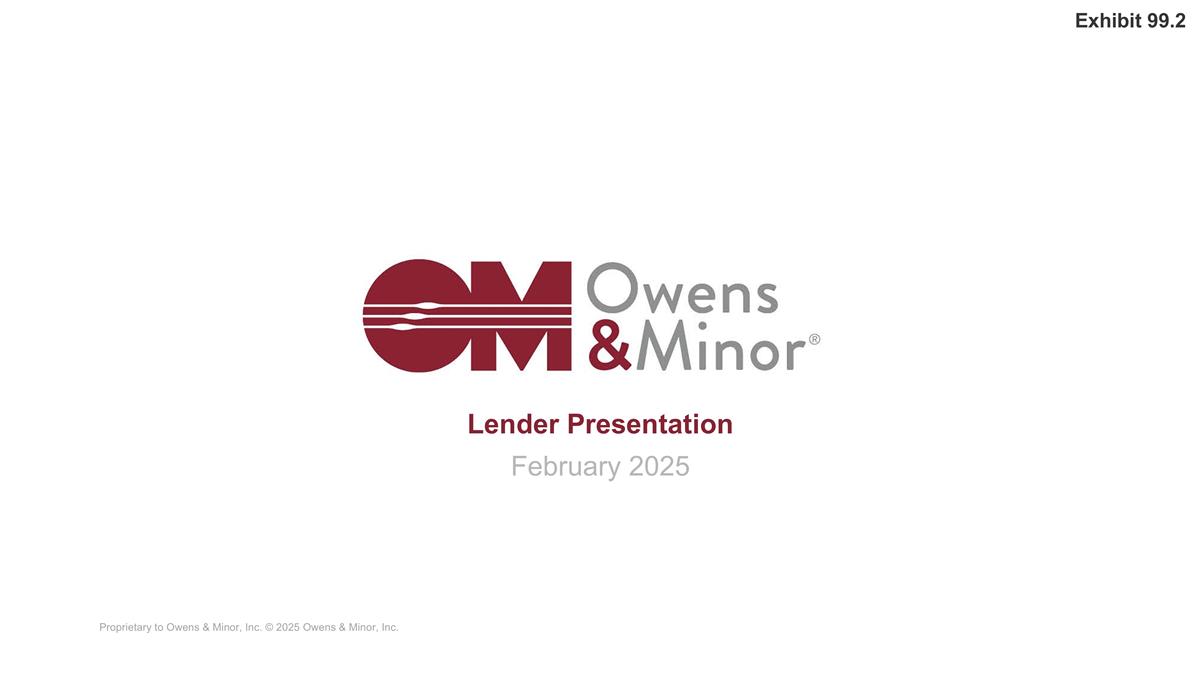
Lender Presentation February 2025 Proprietary to Owens & Minor, Inc. © 2025 Owens & Minor, Inc. Exhibit 99.2
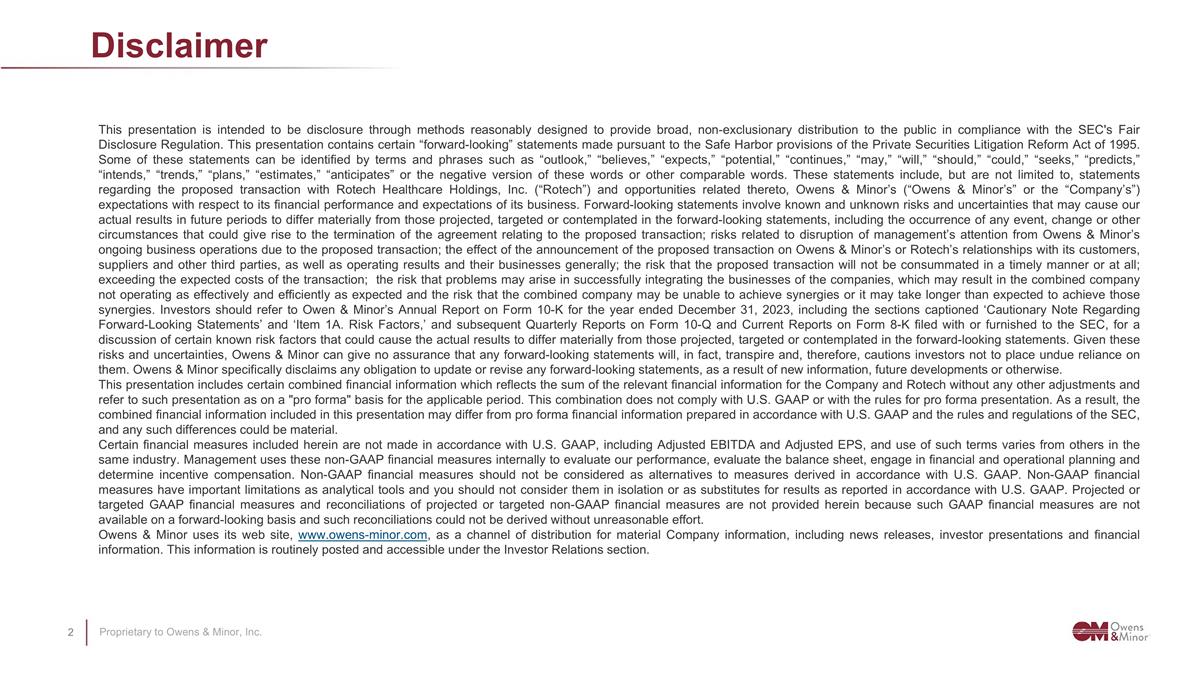
Disclaimer This presentation is intended to be disclosure through methods reasonably designed to provide broad, non-exclusionary distribution to the public in compliance with the SEC's Fair Disclosure Regulation. This presentation contains certain “forward-looking” statements made pursuant to the Safe Harbor provisions of the Private Securities Litigation Reform Act of 1995. Some of these statements can be identified by terms and phrases such as “outlook,” “believes,” “expects,” “potential,” “continues,” “may,” “will,” “should,” “could,” “seeks,” “predicts,” “intends,” “trends,” “plans,” “estimates,” “anticipates” or the negative version of these words or other comparable words. These statements include, but are not limited to, statements regarding the proposed transaction with Rotech Healthcare Holdings, Inc. (“Rotech”) and opportunities related thereto, Owens & Minor’s (“Owens & Minor’s” or the “Company’s”) expectations with respect to its financial performance and expectations of its business. Forward-looking statements involve known and unknown risks and uncertainties that may cause our actual results in future periods to differ materially from those projected, targeted or contemplated in the forward-looking statements, including the occurrence of any event, change or other circumstances that could give rise to the termination of the agreement relating to the proposed transaction; risks related to disruption of management’s attention from Owens & Minor’s ongoing business operations due to the proposed transaction; the effect of the announcement of the proposed transaction on Owens & Minor’s or Rotech’s relationships with its customers, suppliers and other third parties, as well as operating results and their businesses generally; the risk that the proposed transaction will not be consummated in a timely manner or at all; exceeding the expected costs of the transaction; the risk that problems may arise in successfully integrating the businesses of the companies, which may result in the combined company not operating as effectively and efficiently as expected and the risk that the combined company may be unable to achieve synergies or it may take longer than expected to achieve those synergies. Investors should refer to Owen & Minor’s Annual Report on Form 10-K for the year ended December 31, 2023, including the sections captioned ‘Cautionary Note Regarding Forward-Looking Statements’ and ‘Item 1A. Risk Factors,’ and subsequent Quarterly Reports on Form 10-Q and Current Reports on Form 8-K filed with or furnished to the SEC, for a discussion of certain known risk factors that could cause the actual results to differ materially from those projected, targeted or contemplated in the forward-looking statements. Given these risks and uncertainties, Owens & Minor can give no assurance that any forward-looking statements will, in fact, transpire and, therefore, cautions investors not to place undue reliance on them. Owens & Minor specifically disclaims any obligation to update or revise any forward-looking statements, as a result of new information, future developments or otherwise. This presentation includes certain combined financial information which reflects the sum of the relevant financial information for the Company and Rotech without any other adjustments and refer to such presentation as on a "pro forma" basis for the applicable period. This combination does not comply with U.S. GAAP or with the rules for pro forma presentation. As a result, the combined financial information included in this presentation may differ from pro forma financial information prepared in accordance with U.S. GAAP and the rules and regulations of the SEC, and any such differences could be material. Certain financial measures included herein are not made in accordance with U.S. GAAP, including Adjusted EBITDA and Adjusted EPS, and use of such terms varies from others in the same industry. Management uses these non-GAAP financial measures internally to evaluate our performance, evaluate the balance sheet, engage in financial and operational planning and determine incentive compensation. Non-GAAP financial measures should not be considered as alternatives to measures derived in accordance with U.S. GAAP. Non-GAAP financial measures have important limitations as analytical tools and you should not consider them in isolation or as substitutes for results as reported in accordance with U.S. GAAP. Projected or targeted GAAP financial measures and reconciliations of projected or targeted non-GAAP financial measures are not provided herein because such GAAP financial measures are not available on a forward-looking basis and such reconciliations could not be derived without unreasonable effort. Owens & Minor uses its web site, www.owens-minor.com, as a channel of distribution for material Company information, including news releases, investor presentations and financial information. This information is routinely posted and accessible under the Investor Relations section. Proprietary to Owens & Minor, Inc.

Today’s Presenter Jon Leon EVP, Chief Financial Officer Proprietary to Owens & Minor, Inc.
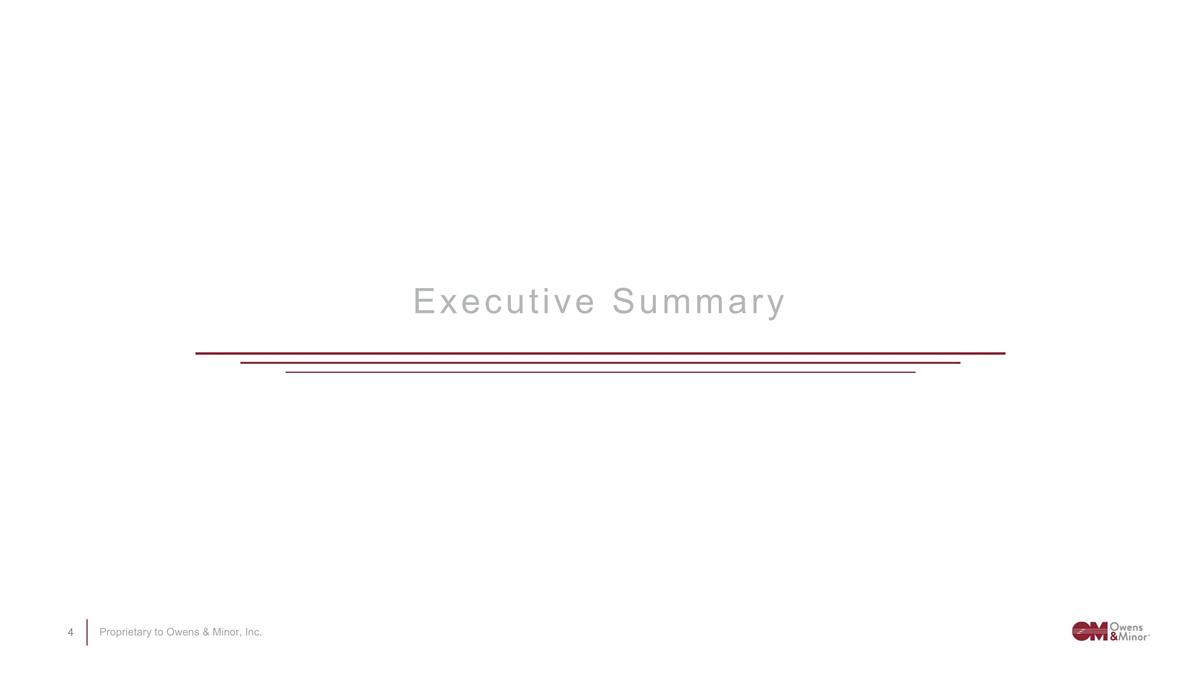
Executive Summary Proprietary to Owens & Minor, Inc.
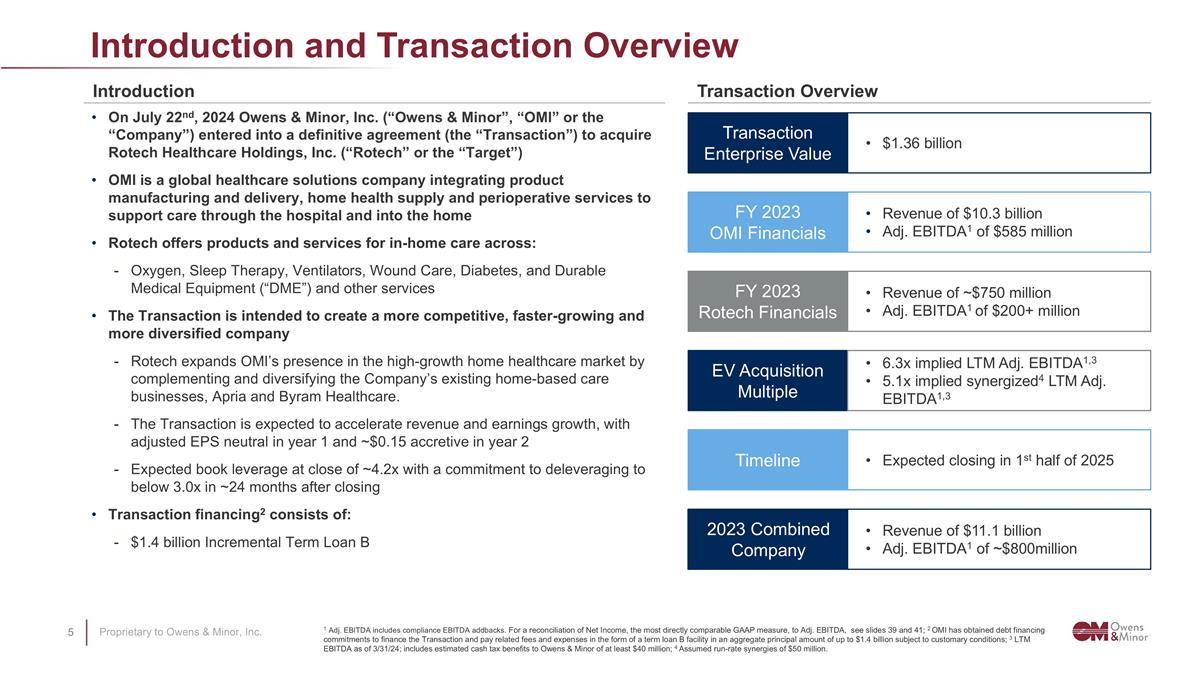
Introduction and Transaction Overview On July 22nd, 2024 Owens & Minor, Inc. (“Owens & Minor”, “OMI” or the “Company”) entered into a definitive agreement (the “Transaction”) to acquire Rotech Healthcare Holdings, Inc. (“Rotech” or the “Target”) OMI is a global healthcare solutions company integrating product manufacturing and delivery, home health supply and perioperative services to support care through the hospital and into the home Rotech offers products and services for in-home care across: Oxygen, Sleep Therapy, Ventilators, Wound Care, Diabetes, and Durable Medical Equipment (“DME”) and other services The Transaction is intended to create a more competitive, faster-growing and more diversified company Rotech expands OMI’s presence in the high-growth home healthcare market by complementing and diversifying the Company’s existing home-based care businesses, Apria and Byram Healthcare. The Transaction is expected to accelerate revenue and earnings growth, with adjusted EPS neutral in year 1 and ~$0.15 accretive in year 2 Expected book leverage at close of ~4.2x with a commitment to deleveraging to below 3.0x in ~24 months after closing Transaction financing2 consists of: $1.4 billion Incremental Term Loan B Transaction Enterprise Value $1.36 billion FY 2023 OMI Financials Revenue of $10.3 billion Adj. EBITDA1 of $585 million EV Acquisition Multiple 6.3x implied LTM Adj. EBITDA1,3 5.1x implied synergized4 LTM Adj. EBITDA1,3 Timeline Expected closing in 1st half of 2025 2023 Combined Company Revenue of $11.1 billion Adj. EBITDA1 of ~$800million FY 2023 Rotech Financials Revenue of ~$750 million Adj. EBITDA1 of $200+ million Transaction Overview Introduction 1 Adj. EBITDA includes compliance EBITDA addbacks. For a reconciliation of Net Income, the most directly comparable GAAP measure, to Adj. EBITDA, see slides 39 and 41; 2 OMI has obtained debt financing commitments to finance the Transaction and pay related fees and expenses in the form of a term loan B facility in an aggregate principal amount of up to $1.4 billion subject to customary conditions; 3 LTM EBITDA as of 3/31/24; includes estimated cash tax benefits to Owens & Minor of at least $40 million; 4 Assumed run-rate synergies of $50 million. Proprietary to Owens & Minor, Inc.
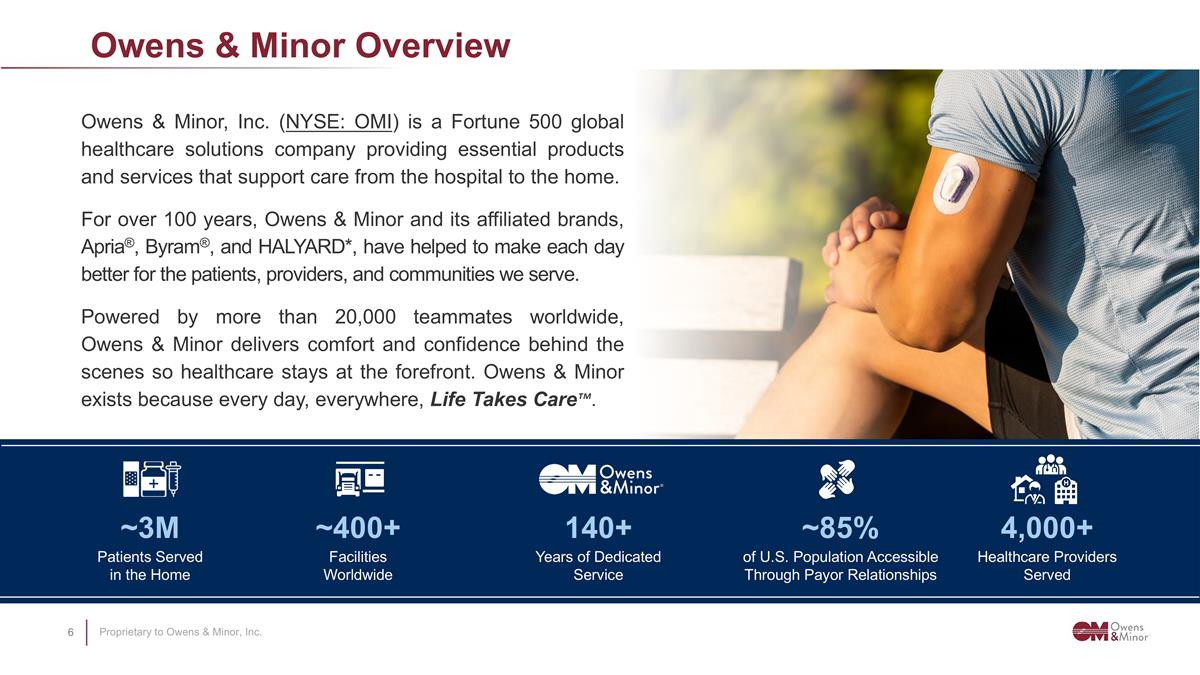
Owens & Minor Overview 4,000+ Healthcare Providers Served 140+ Years of Dedicated Service ~400+ Facilities Worldwide ~85% of U.S. Population Accessible Through Payor Relationships ~3M Patients Served in the Home Owens & Minor, Inc. (NYSE: OMI) is a Fortune 500 global healthcare solutions company providing essential products and services that support care from the hospital to the home. For over 100 years, Owens & Minor and its affiliated brands, Apria®, Byram®, and HALYARD*, have helped to make each day better for the patients, providers, and communities we serve. Powered by more than 20,000 teammates worldwide, Owens & Minor delivers comfort and confidence behind the scenes so healthcare stays at the forefront. Owens & Minor exists because every day, everywhere, Life Takes Care™. Proprietary to Owens & Minor, Inc.
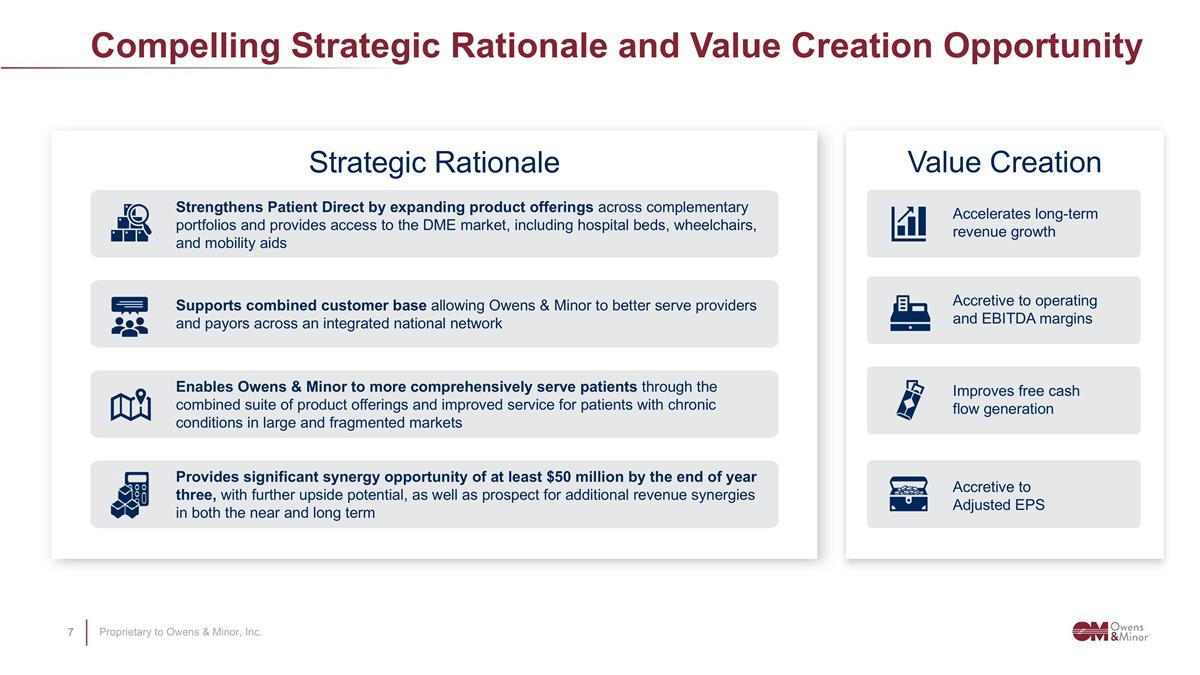
Compelling Strategic Rationale and Value Creation Opportunity Strategic Rationale Value Creation Accelerates long-term revenue growth Accretive to operating and EBITDA margins Improves free cash flow generation Accretive to Adjusted EPS Strengthens Patient Direct by expanding product offerings across complementary portfolios and provides access to the DME market, including hospital beds, wheelchairs, and mobility aids Supports combined customer base allowing Owens & Minor to better serve providers and payors across an integrated national network Enables Owens & Minor to more comprehensively serve patients through the combined suite of product offerings and improved service for patients with chronic conditions in large and fragmented markets Provides significant synergy opportunity of at least $50 million by the end of year three, with further upside potential, as well as prospect for additional revenue synergies in both the near and long term Proprietary to Owens & Minor, Inc.
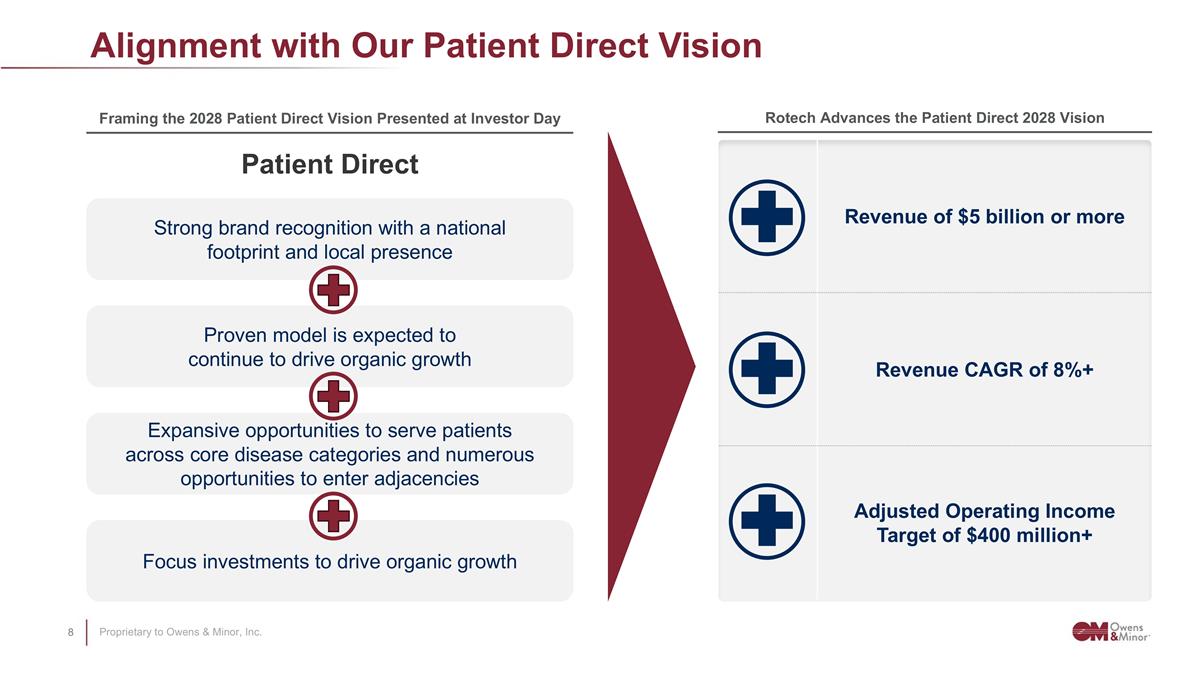
Alignment with Our Patient Direct Vision Framing the 2028 Patient Direct Vision Presented at Investor Day Patient Direct Strong brand recognition with a national footprint and local presence Proven model is expected to continue to drive organic growth Expansive opportunities to serve patients across core disease categories and numerous opportunities to enter adjacencies Focus investments to drive organic growth Revenue of $5 billion or more Revenue CAGR of 8%+ Adjusted Operating Income Target of $400 million+ Rotech Advances the Patient Direct 2028 Vision Proprietary to Owens & Minor, Inc.
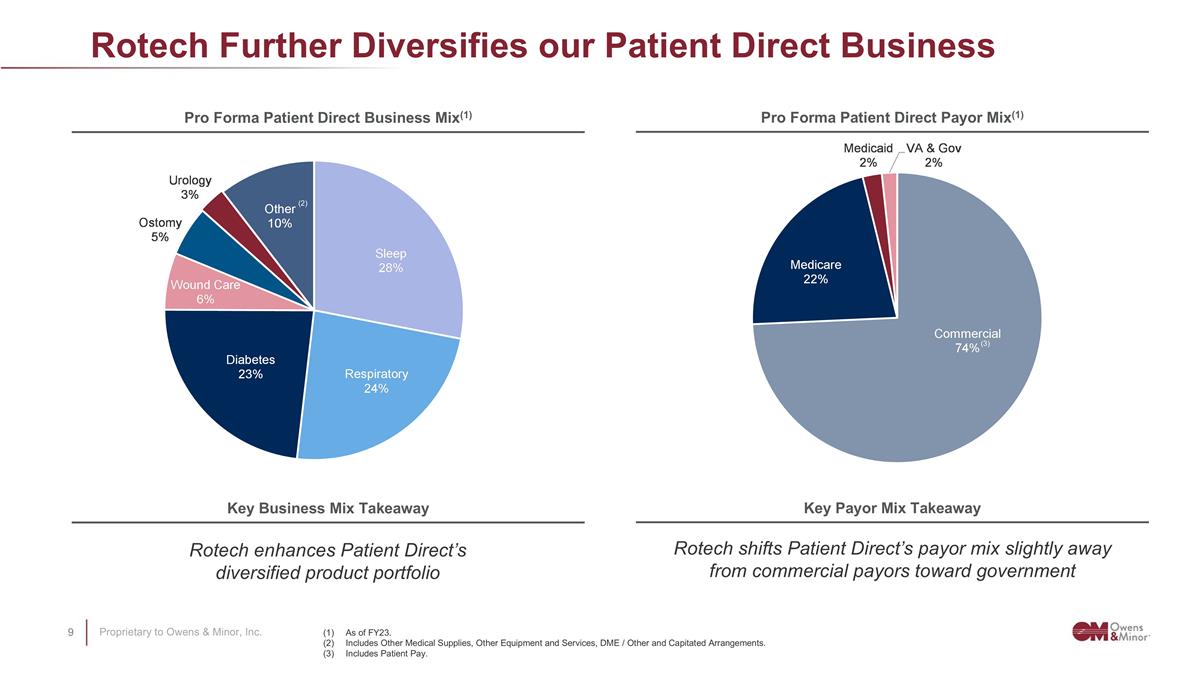
Rotech Further Diversifies our Patient Direct Business Proprietary to Owens & Minor, Inc. Rotech enhances Patient Direct’s diversified product portfolio Rotech shifts Patient Direct’s payor mix slightly away from commercial payors toward government Pro Forma Patient Direct Payor Mix(1) Pro Forma Patient Direct Business Mix(1) Key Payor Mix Takeaway Key Business Mix Takeaway As of FY23. Includes Other Medical Supplies, Other Equipment and Services, DME / Other and Capitated Arrangements. Includes Patient Pay. (3) (2)
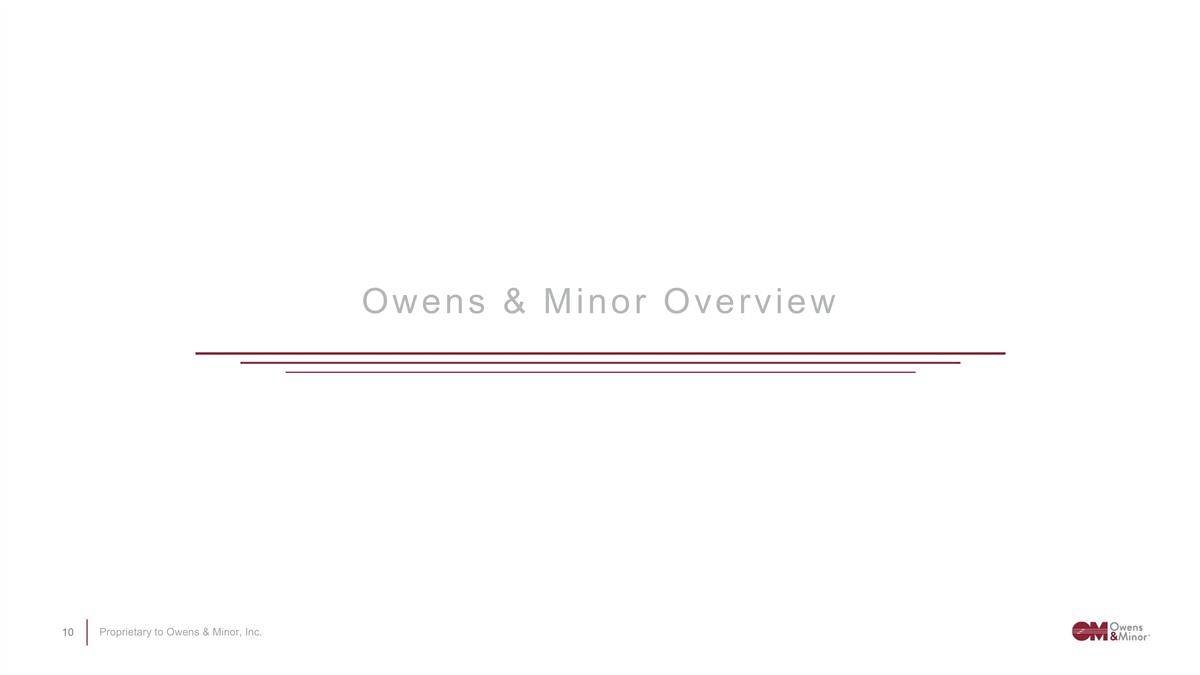
Owens & Minor Overview Proprietary to Owens & Minor, Inc.
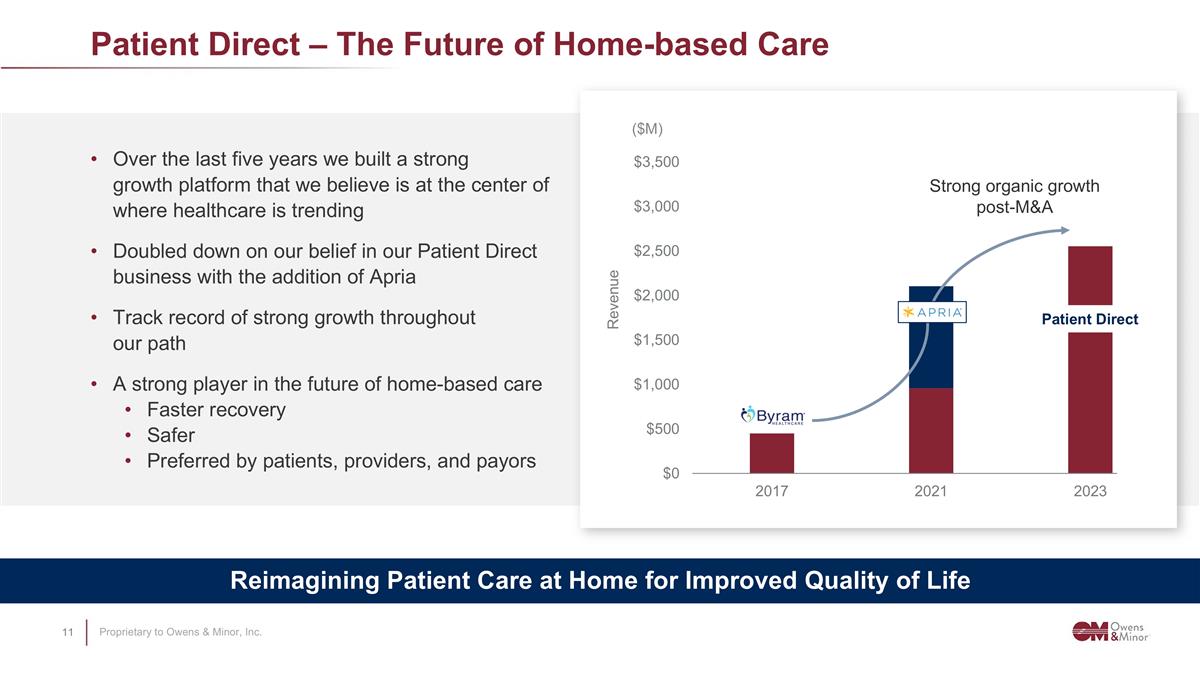
Patient Direct – The Future of Home-based Care Over the last five years we built a strong growth platform that we believe is at the center of where healthcare is trending Doubled down on our belief in our Patient Direct business with the addition of Apria Track record of strong growth throughout our path A strong player in the future of home-based care Faster recovery Safer Preferred by patients, providers, and payors Reimagining Patient Care at Home for Improved Quality of Life Strong organic growth post-M&A ($M) Revenue Patient Direct Proprietary to Owens & Minor, Inc.
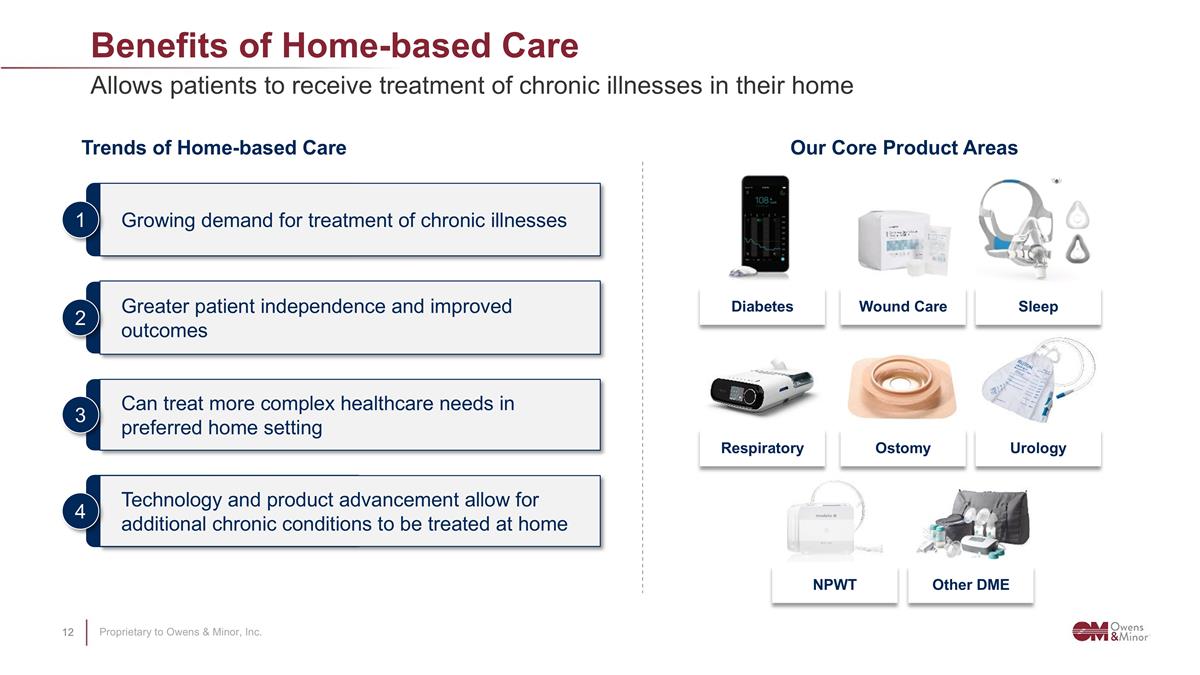
Benefits of Home-based Care Allows patients to receive treatment of chronic illnesses in their home Greater patient independence and improved outcomes 2 1 Growing demand for treatment of chronic illnesses Technology and product advancement allow for additional chronic conditions to be treated at home 4 Trends of Home-based Care Our Core Product Areas Diabetes Wound Care Sleep Respiratory Ostomy Urology NPWT Other DME 3 Can treat more complex healthcare needs in preferred home setting Proprietary to Owens & Minor, Inc.
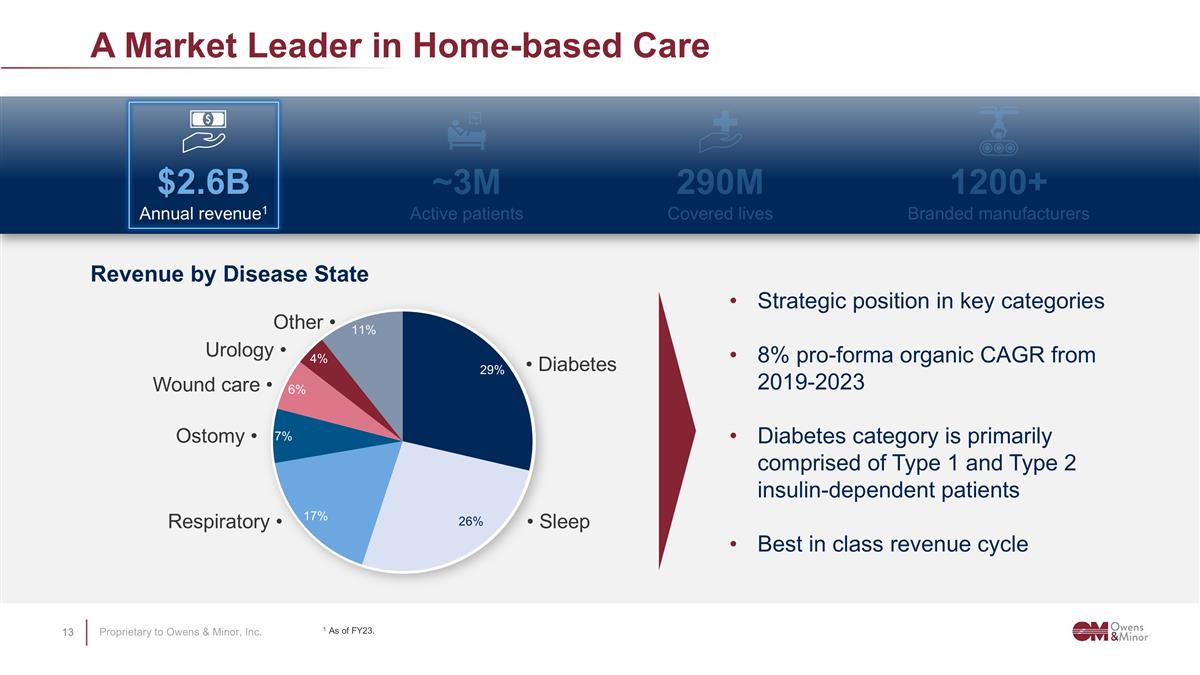
A Market Leader in Home-based Care 290M Covered lives 1200+ Branded manufacturers ~3M Active patients $2.6B Annual revenue1 • • • • • • • Strategic position in key categories 8% pro-forma organic CAGR from 2019-2023 Diabetes category is primarily comprised of Type 1 and Type 2 insulin-dependent patients Best in class revenue cycle Revenue by Disease State 1 As of FY23. Proprietary to Owens & Minor, Inc.
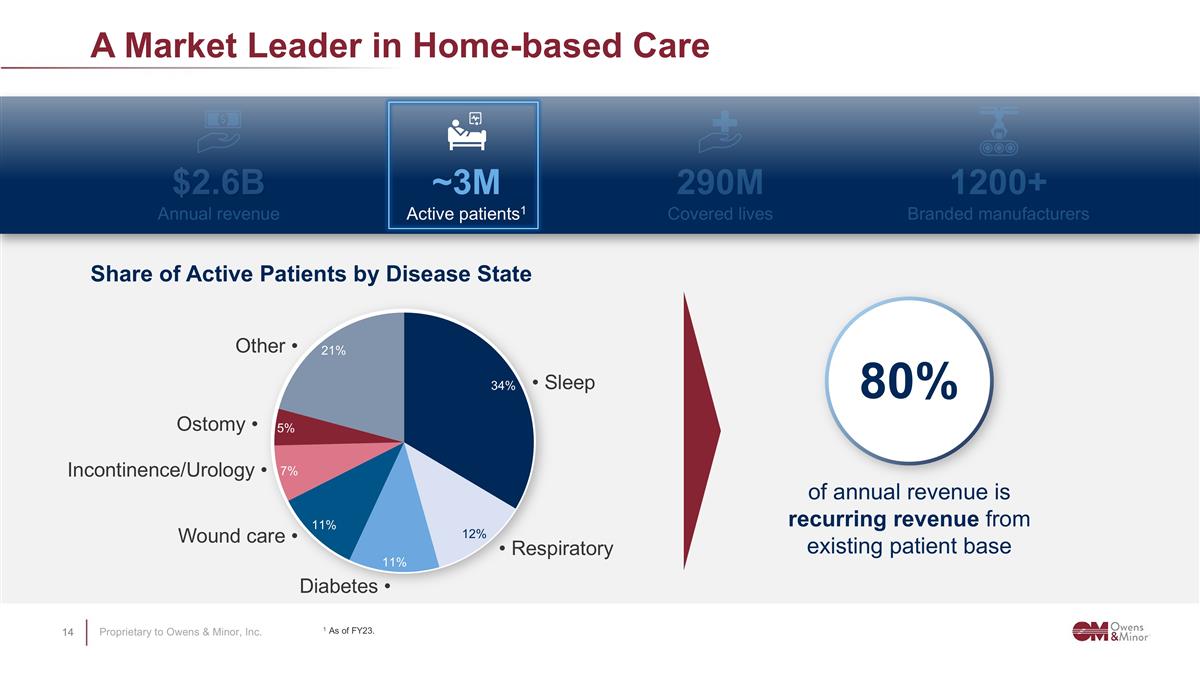
Share of Active Patients by Disease State of annual revenue is recurring revenue from existing patient base 80% • • • • Incontinence/Urology • • • A Market Leader in Home-based Care 290M Covered lives 1200+ Branded manufacturers ~3M Active patients1 $2.6B Annual revenue 1 As of FY23. Proprietary to Owens & Minor, Inc.
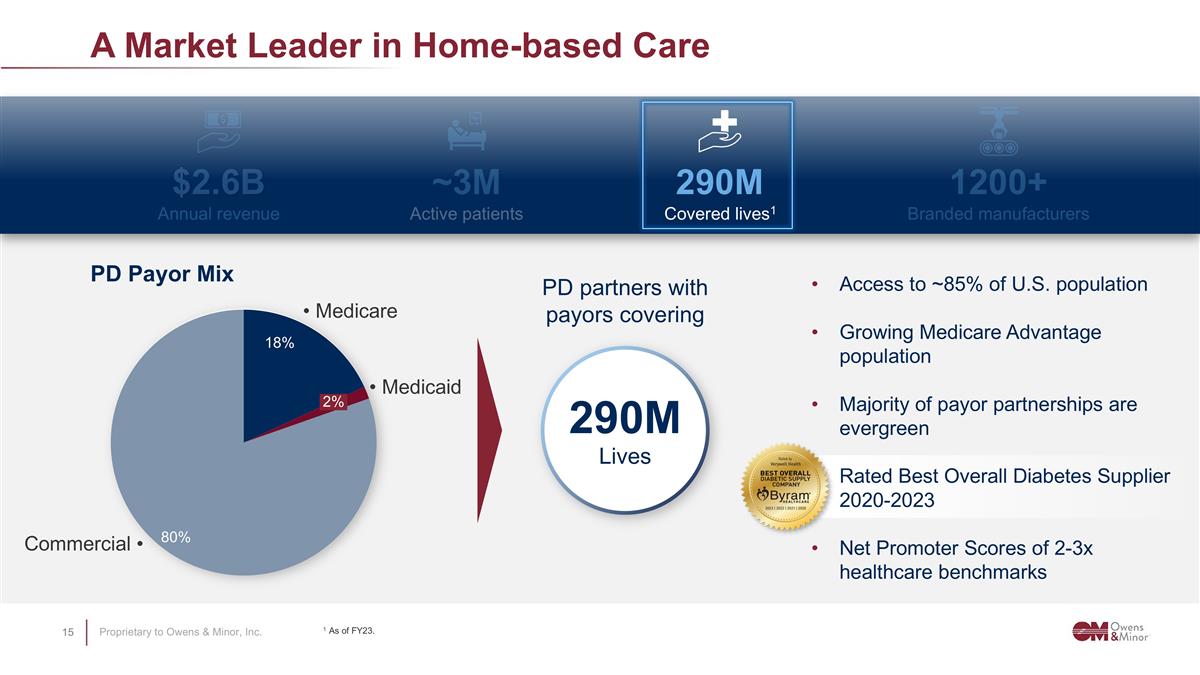
• • • PD partners with payors covering 290M Lives PD Payor Mix A Market Leader in Home-based Care Covered lives1 1200+ Branded manufacturers $2.6B Annual revenue Access to ~85% of U.S. population Growing Medicare Advantage population Majority of payor partnerships are evergreen Rated Best Overall Diabetes Supplier 2020-2023 Net Promoter Scores of 2-3x healthcare benchmarks 290M Active patients ~3M 1 As of FY23. Proprietary to Owens & Minor, Inc.
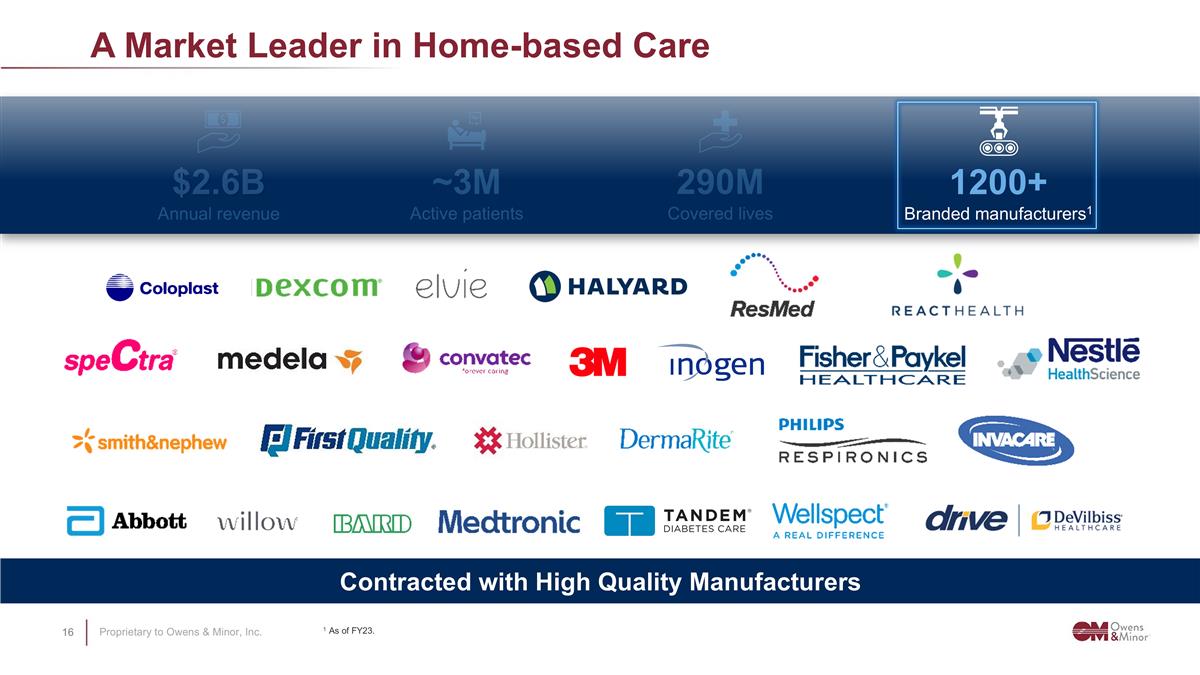
A Market Leader in Home-based Care 1200+ Branded manufacturers1 $2.6B Annual revenue Contracted with High Quality Manufacturers Proprietary to Owens & Minor, Inc. 290M Covered lives ~3M Active patients 1 As of FY23.
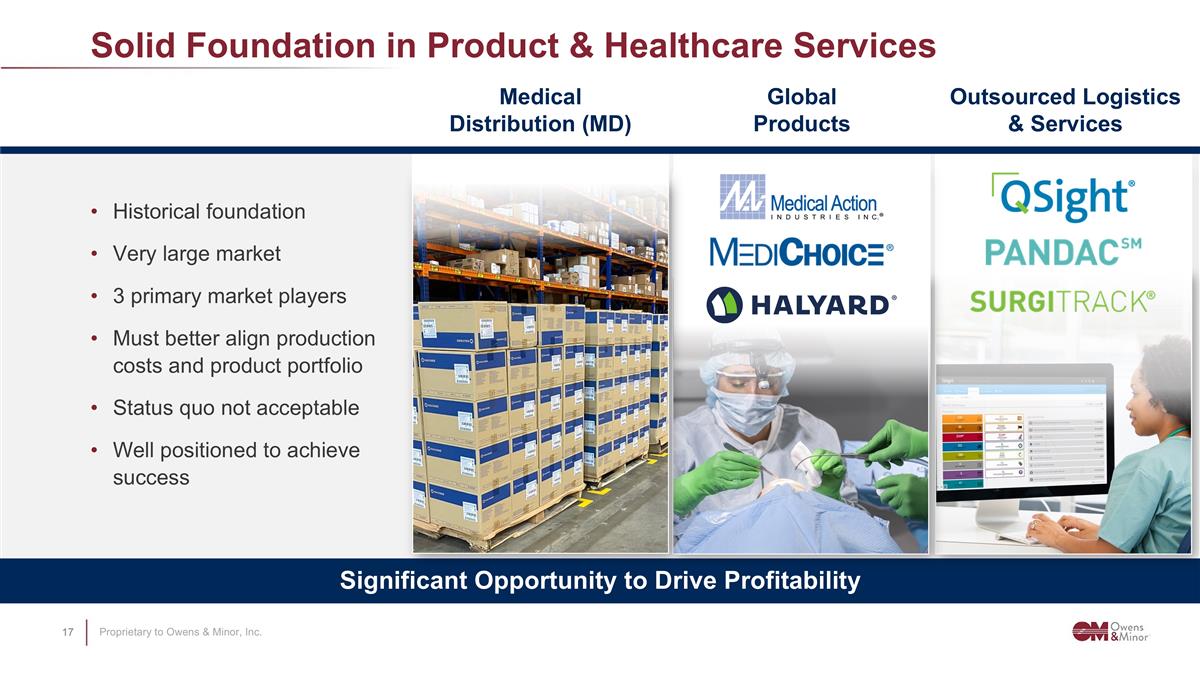
Solid Foundation in Product & Healthcare Services Historical foundation Very large market 3 primary market players Must better align production costs and product portfolio Status quo not acceptable Well positioned to achieve success Significant Opportunity to Drive Profitability Medical Distribution (MD) Global Products Outsourced Logistics & Services Proprietary to Owens & Minor, Inc.
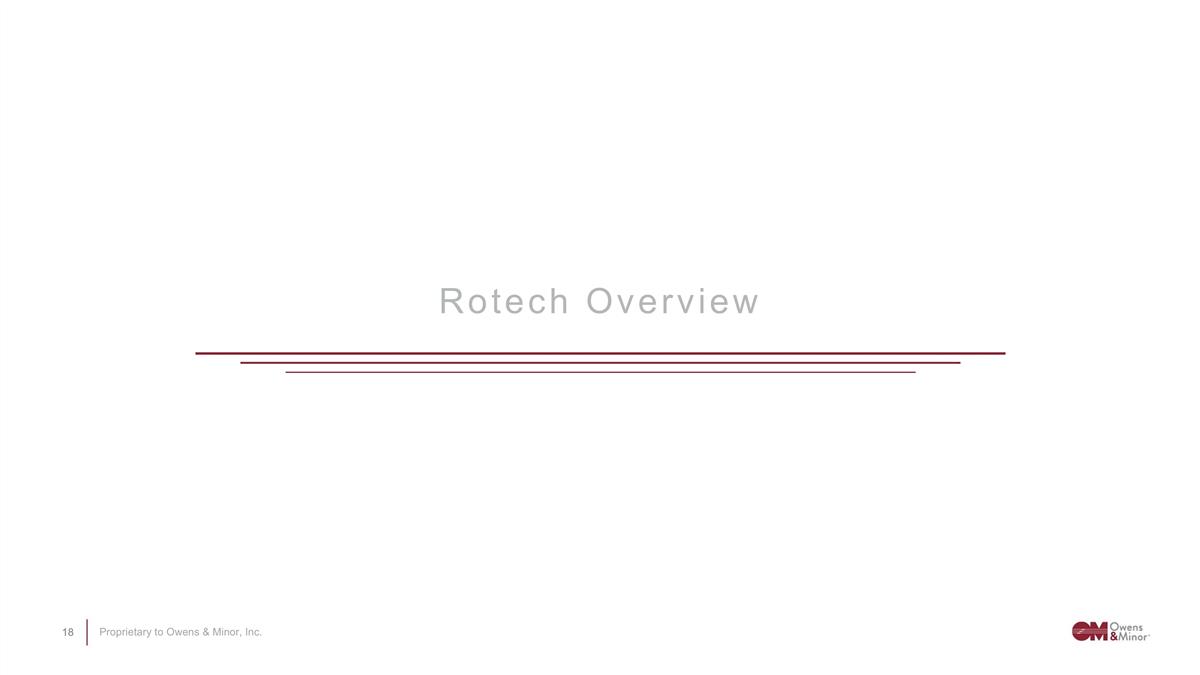
Rotech Overview Proprietary to Owens & Minor, Inc.
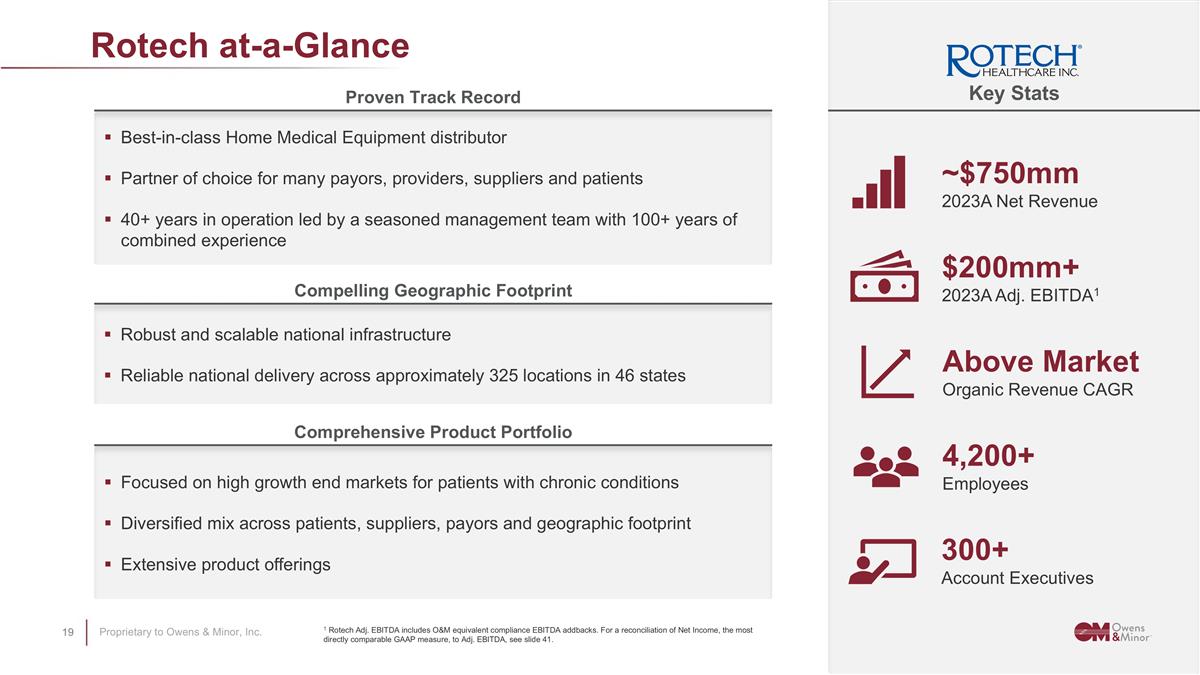
Rotech at-a-Glance Proven Track Record Best-in-class Home Medical Equipment distributor Partner of choice for many payors, providers, suppliers and patients 40+ years in operation led by a seasoned management team with 100+ years of combined experience Compelling Geographic Footprint Robust and scalable national infrastructure Reliable national delivery across approximately 325 locations in 46 states Comprehensive Product Portfolio Focused on high growth end markets for patients with chronic conditions Diversified mix across patients, suppliers, payors and geographic footprint Extensive product offerings Key Stats ~$750mm 2023A Net Revenue $200mm+ 2023A Adj. EBITDA1 Above Market Organic Revenue CAGR 4,200+ Employees 300+ Account Executives 1 Rotech Adj. EBITDA includes O&M equivalent compliance EBITDA addbacks. For a reconciliation of Net Income, the most directly comparable GAAP measure, to Adj. EBITDA, see slide 41. Proprietary to Owens & Minor, Inc.
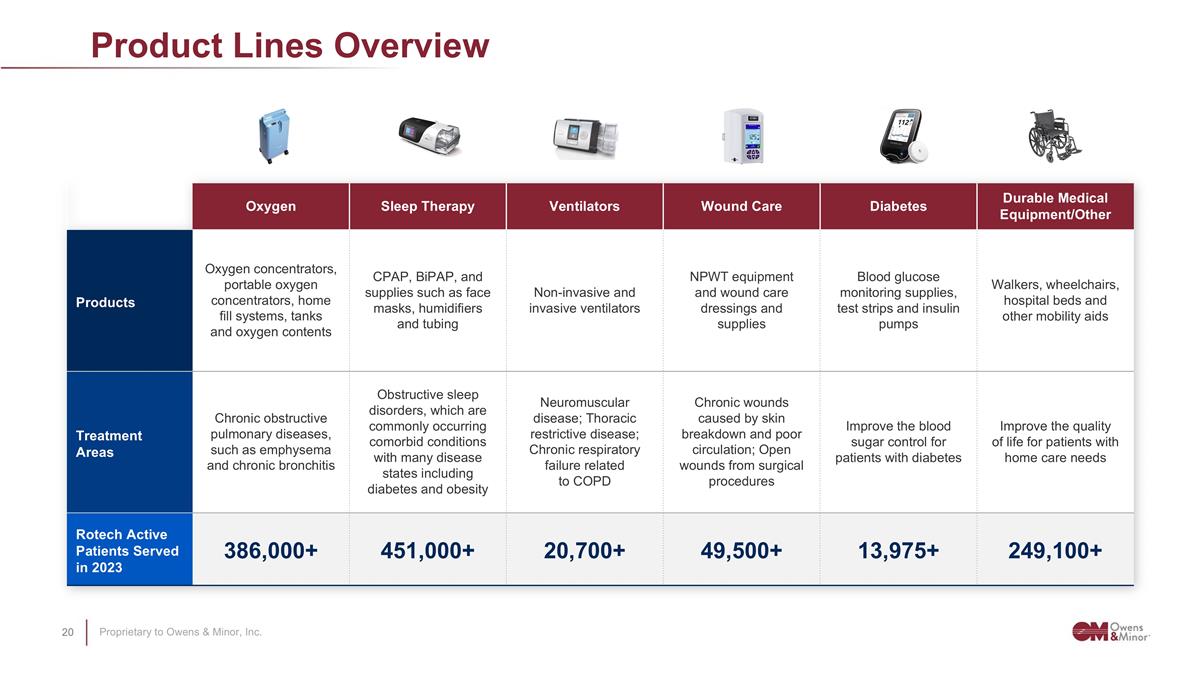
Product Lines Overview Oxygen Sleep Therapy Ventilators Wound Care Diabetes Durable Medical Equipment/Other Products Oxygen concentrators, portable oxygen concentrators, home fill systems, tanks and oxygen contents CPAP, BiPAP, and supplies such as face masks, humidifiers and tubing Non-invasive and invasive ventilators NPWT equipment and wound care dressings and supplies Blood glucose monitoring supplies, test strips and insulin pumps Walkers, wheelchairs, hospital beds and other mobility aids Treatment Areas Chronic obstructive pulmonary diseases, such as emphysema and chronic bronchitis Obstructive sleep disorders, which are commonly occurring comorbid conditions with many disease states including diabetes and obesity Neuromuscular disease; Thoracic restrictive disease; Chronic respiratory failure related to COPD Chronic wounds caused by skin breakdown and poor circulation; Open wounds from surgical procedures Improve the blood sugar control for patients with diabetes Improve the quality of life for patients with home care needs Rotech Active Patients Served in 2023 386,000+ 451,000+ 20,700+ 49,500+ 13,975+ 249,100+ Proprietary to Owens & Minor, Inc.
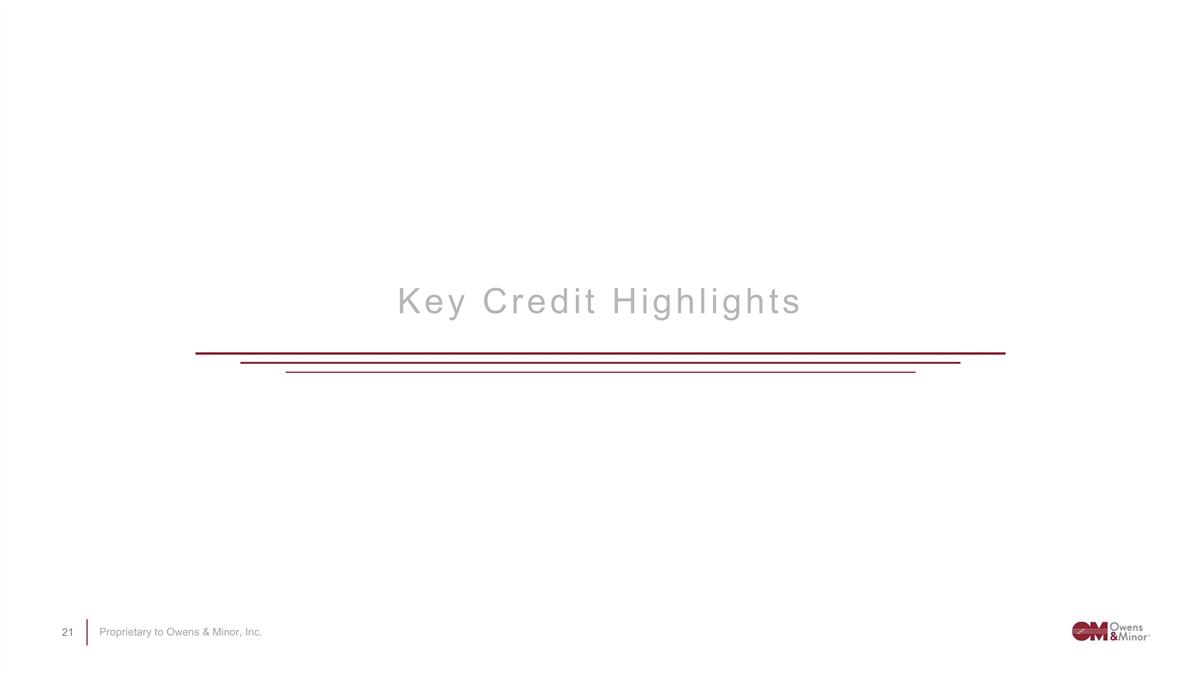
Key Credit Highlights Proprietary to Owens & Minor, Inc.
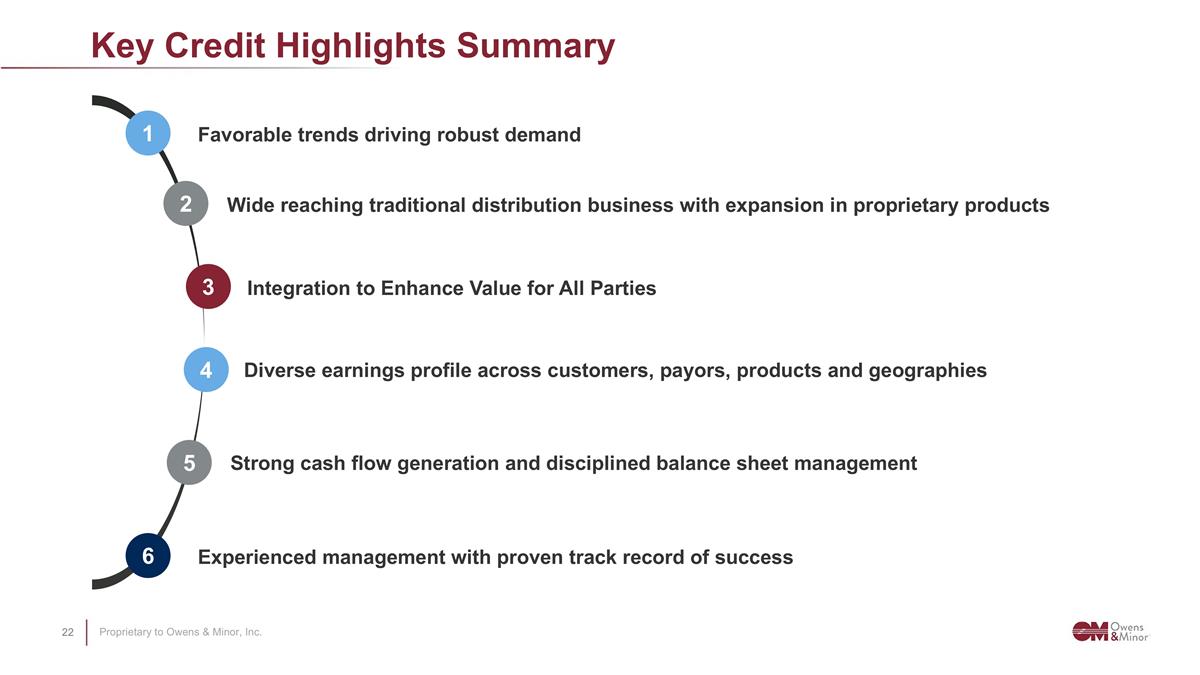
Key Credit Highlights Summary 1 Favorable trends driving robust demand 5 Strong cash flow generation and disciplined balance sheet management 4 Diverse earnings profile across customers, payors, products and geographies 2 Wide reaching traditional distribution business with expansion in proprietary products 6 Experienced management with proven track record of success Integration to Enhance Value for All Parties 3 Proprietary to Owens & Minor, Inc.
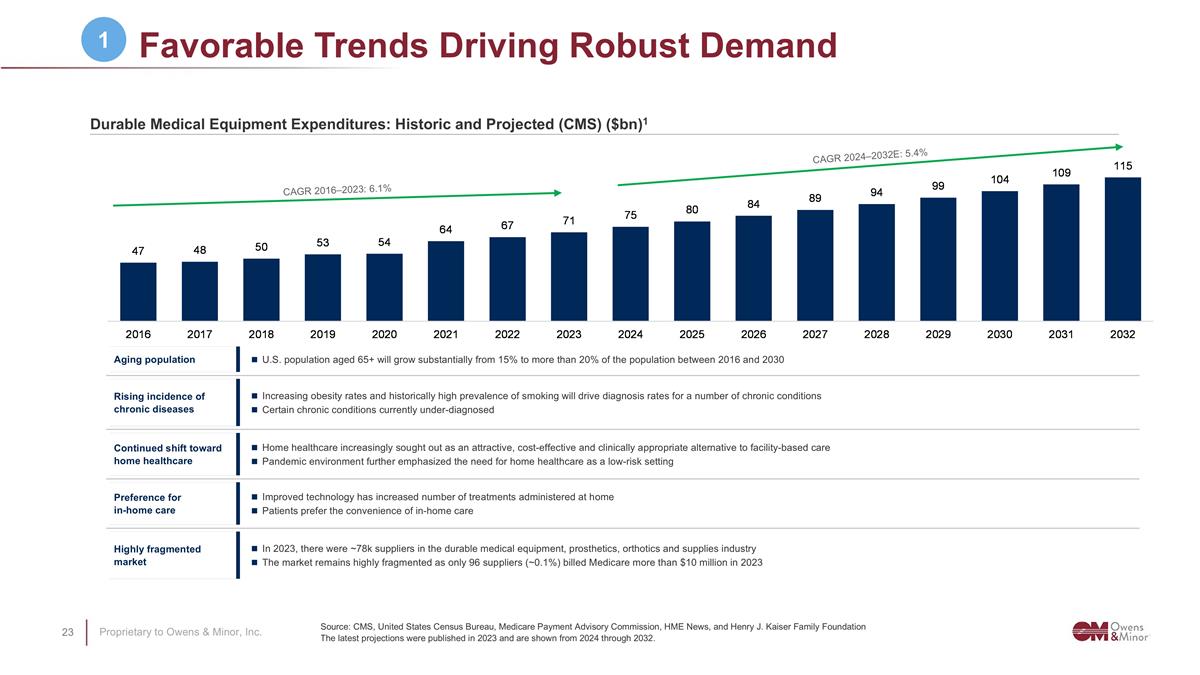
Favorable Trends Driving Robust Demand Durable Medical Equipment Expenditures: Historic and Projected (CMS) ($bn)1 CAGR 2016–2023: 6.1% CAGR 2024–2032E: 5.4% Aging population Continued shift toward home healthcare Rising incidence of chronic diseases Preference for in-home care Highly fragmented market U.S. population aged 65+ will grow substantially from 15% to more than 20% of the population between 2016 and 2030 Increasing obesity rates and historically high prevalence of smoking will drive diagnosis rates for a number of chronic conditions Certain chronic conditions currently under-diagnosed Home healthcare increasingly sought out as an attractive, cost-effective and clinically appropriate alternative to facility-based care Pandemic environment further emphasized the need for home healthcare as a low-risk setting Improved technology has increased number of treatments administered at home Patients prefer the convenience of in-home care In 2023, there were ~78k suppliers in the durable medical equipment, prosthetics, orthotics and supplies industry The market remains highly fragmented as only 96 suppliers (~0.1%) billed Medicare more than $10 million in 2023 Aging population Continued shift toward home healthcare Rising incidence of chronic diseases Preference for in-home care Highly fragmented market SSource: CMS, United States Census Bureau, Medicare Payment Advisory Commission, HME News, and Henry J. Kaiser Family Foundation 1 The latest projections were published in 2023 and are shown from 2024 through 2032. 1 Proprietary to Owens & Minor, Inc.
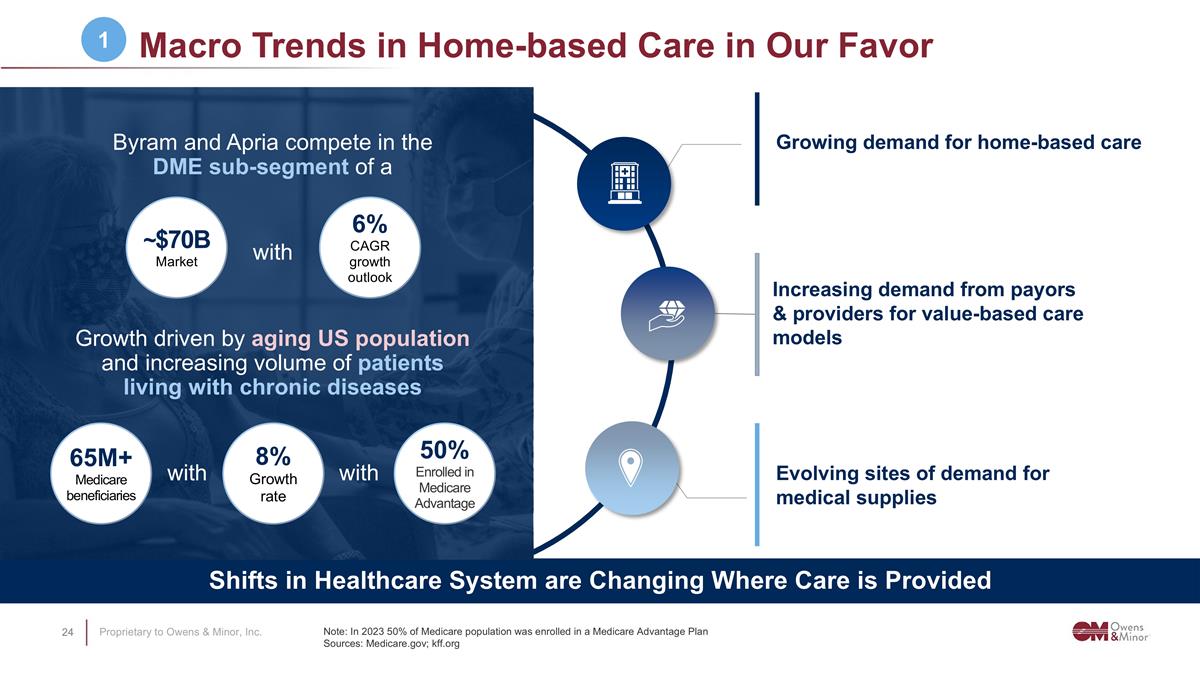
Macro Trends in Home-based Care in Our Favor Byram and Apria compete in the DME sub-segment of a Growth driven by aging US population and increasing volume of patients living with chronic diseases Growing demand for home-based care Increasing demand from payors & providers for value-based care models Evolving sites of demand for medical supplies ~$70B Market with 6% CAGR growth outlook Shifts in Healthcare System are Changing Where Care is Provided Note: In 2023 50% of Medicare population was enrolled in a Medicare Advantage Plan Sources: Medicare.gov; kff.org 65M+ Medicare beneficiaries with 8% Growth rate 50% Enrolled in Medicare Advantage with Proprietary to Owens & Minor, Inc. 1
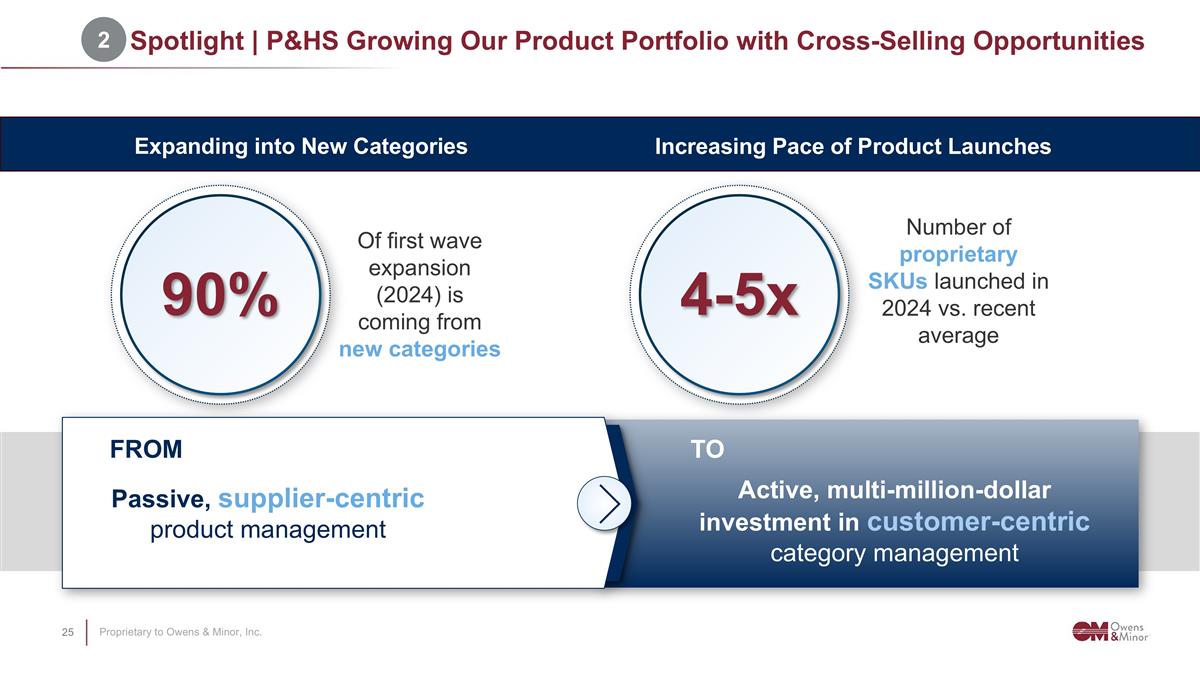
Spotlight | P&HS Growing Our Product Portfolio with Cross-Selling Opportunities Expanding into New Categories Increasing Pace of Product Launches 90% Active, multi-million-dollar investment in customer-centric category management Passive, supplier-centric product management FROM TO Of first wave expansion (2024) is coming from new categories Number of proprietary SKUs launched in 2024 vs. recent average 4-5x 2 Proprietary to Owens & Minor, Inc.
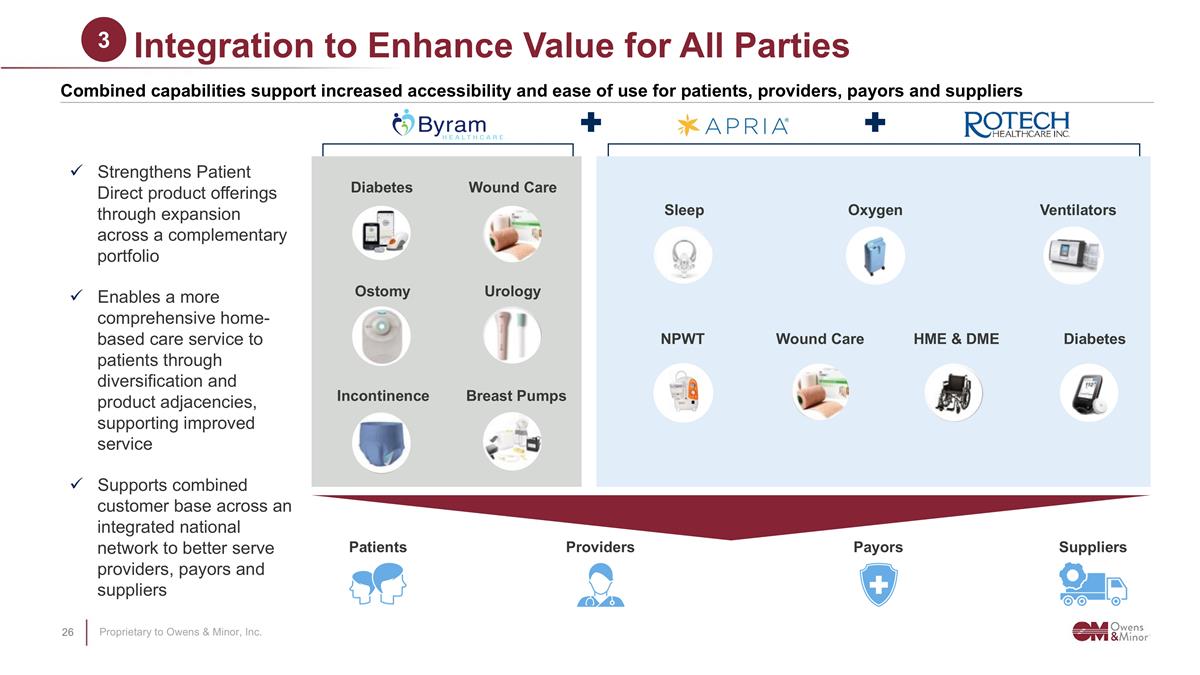
A Integration to Enhance Value for All Parties 3 Ostomy Urology Patients Providers Payors Suppliers Strengthens Patient Direct product offerings through expansion across a complementary portfolio Enables a more comprehensive home-based care service to patients through diversification and product adjacencies, supporting improved service Supports combined customer base across an integrated national network to better serve providers, payors and suppliers Combined capabilities support increased accessibility and ease of use for patients, providers, payors and suppliers Diabetes Wound Care Incontinence Breast Pumps Sleep Oxygen Ventilators HME & DME NPWT Diabetes Wound Care Proprietary to Owens & Minor, Inc.
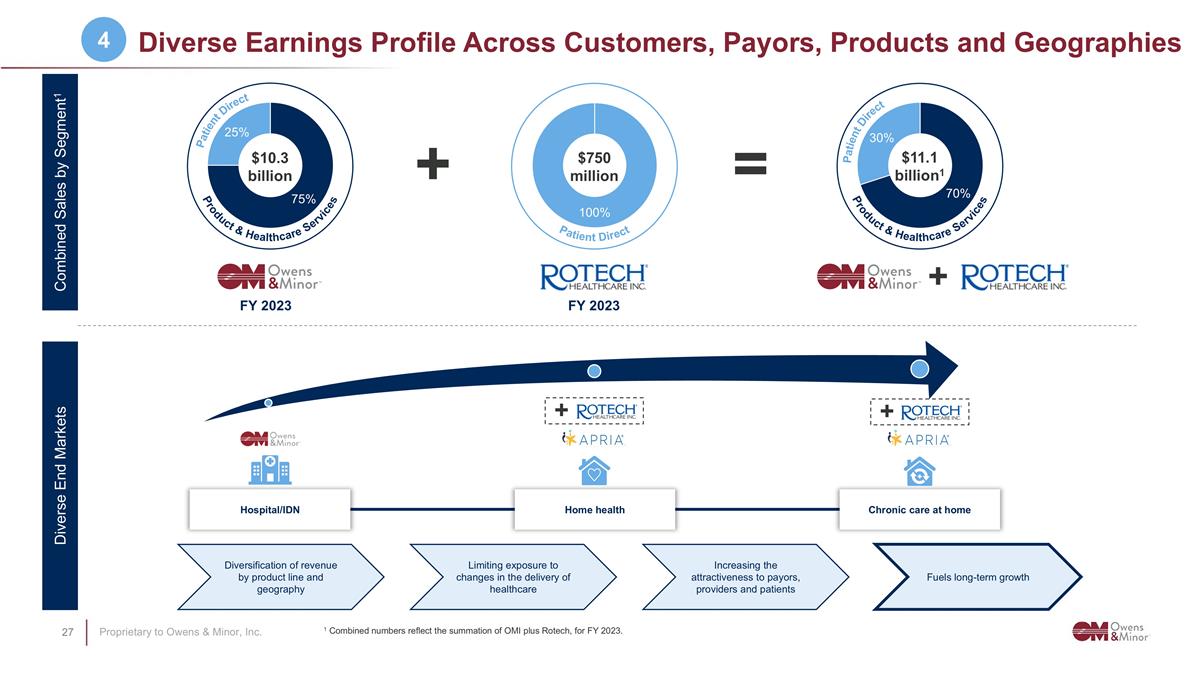
Diverse Earnings Profile Across Customers, Payors, Products and Geographies + + = Combined Sales by Segment1 1 Combined numbers reflect the summation of OMI plus Rotech, for FY 2023. Diversification of revenue by product line and geography Limiting exposure to changes in the delivery of healthcare Increasing the attractiveness to payors, providers and patients Fuels long-term growth Hospital/IDN Home health Chronic care at home + Diverse End Markets FY 2023 FY 2023 + Product & Healthcare Services Product & Healthcare Services Patient Direct Patient Direct Patient Direct $750 million $10.3 billion $11.1 billion1 4 Proprietary to Owens & Minor, Inc.
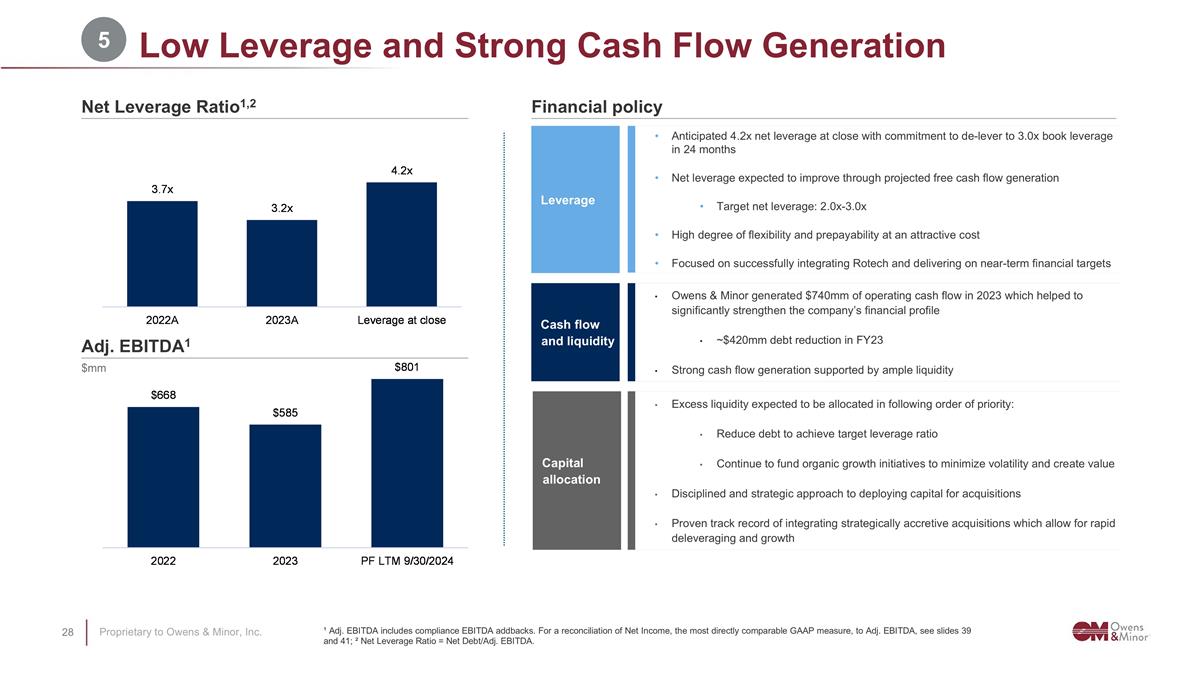
Low Leverage and Strong Cash Flow Generation ¹ Adj. EBITDA includes compliance EBITDA addbacks. For a reconciliation of Net Income, the most directly comparable GAAP measure, to Adj. EBITDA, see slides 39 and 41; ² Net Leverage Ratio = Net Debt/Adj. EBITDA. Leverage Anticipated 4.2x net leverage at close with commitment to de-lever to 3.0x book leverage in 24 months Net leverage expected to improve through projected free cash flow generation Target net leverage: 2.0x-3.0x High degree of flexibility and prepayability at an attractive cost Focused on successfully integrating Rotech and delivering on near-term financial targets Cash flow and liquidity Owens & Minor generated $740mm of operating cash flow in 2023 which helped to significantly strengthen the company’s financial profile ~$420mm debt reduction in FY23 Strong cash flow generation supported by ample liquidity Capital allocation Excess liquidity expected to be allocated in following order of priority: Reduce debt to achieve target leverage ratio Continue to fund organic growth initiatives to minimize volatility and create value Disciplined and strategic approach to deploying capital for acquisitions Proven track record of integrating strategically accretive acquisitions which allow for rapid deleveraging and growth Financial policy Net Leverage Ratio1,2 Adj. EBITDA1 $mm 5 Proprietary to Owens & Minor, Inc.
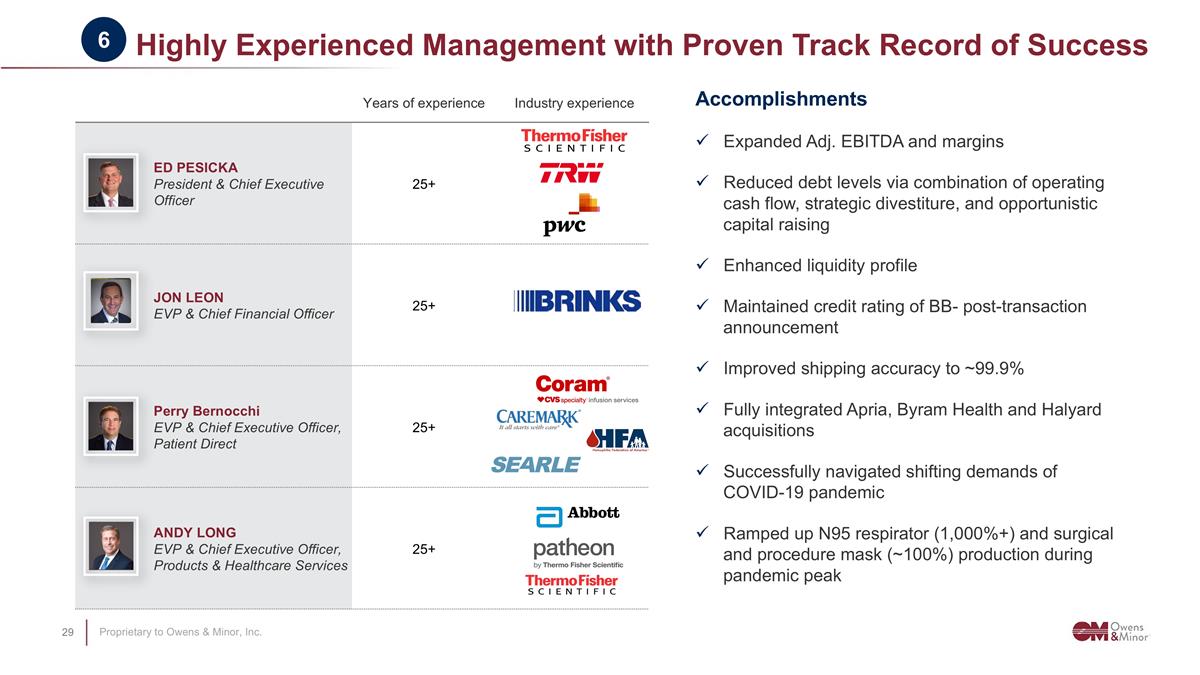
Highly Experienced Management with Proven Track Record of Success Years of experience Industry experience ED PESICKA President & Chief Executive Officer 25+ JON LEON EVP & Chief Financial Officer 25+ Perry Bernocchi EVP & Chief Executive Officer, Patient Direct 25+ ANDY LONG EVP & Chief Executive Officer, Products & Healthcare Services 25+ Accomplishments Expanded Adj. EBITDA and margins Reduced debt levels via combination of operating cash flow, strategic divestiture, and opportunistic capital raising Enhanced liquidity profile Maintained credit rating of BB- post-transaction announcement Improved shipping accuracy to ~99.9% Fully integrated Apria, Byram Health and Halyard acquisitions Successfully navigated shifting demands of COVID-19 pandemic Ramped up N95 respirator (1,000%+) and surgical and procedure mask (~100%) production during pandemic peak 6 Proprietary to Owens & Minor, Inc.
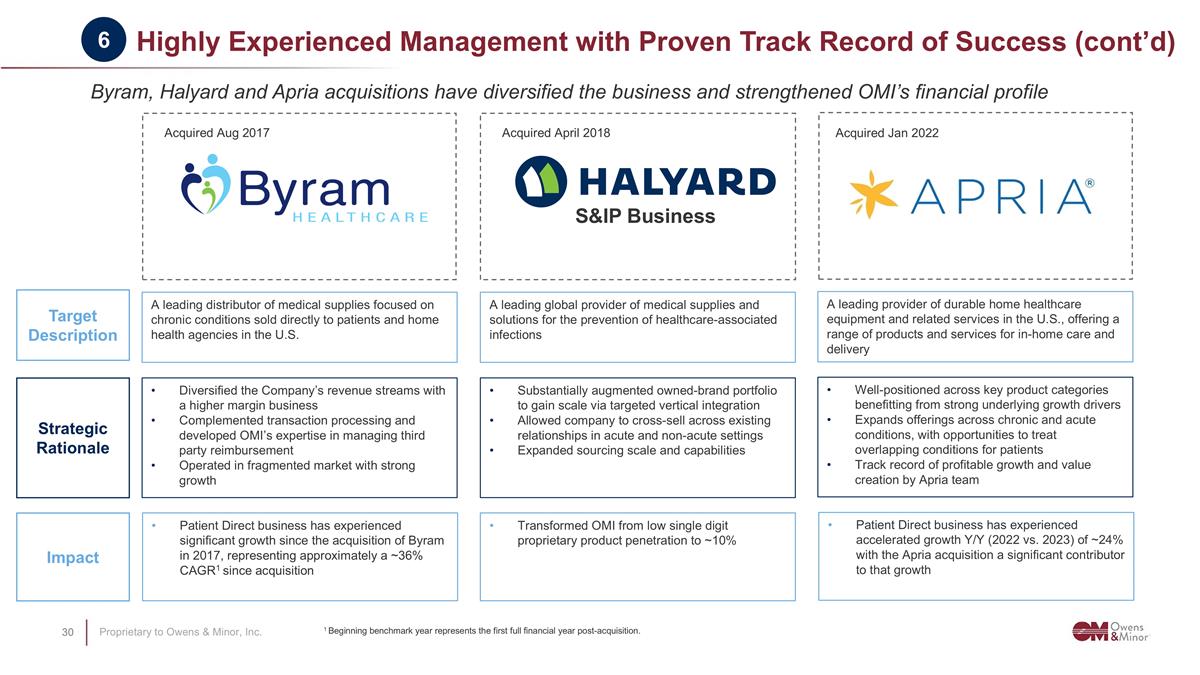
1 Beginning benchmark year represents the first full financial year post-acquisition. Highly Experienced Management with Proven Track Record of Success (cont’d) Byram, Halyard and Apria acquisitions have diversified the business and strengthened OMI’s financial profile S&IP Business Acquired April 2018 Acquired Aug 2017 A leading distributor of medical supplies focused on chronic conditions sold directly to patients and home health agencies in the U.S. A leading global provider of medical supplies and solutions for the prevention of healthcare-associated infections Target Description Diversified the Company’s revenue streams with a higher margin business Complemented transaction processing and developed OMI’s expertise in managing third party reimbursement Operated in fragmented market with strong growth Substantially augmented owned-brand portfolio to gain scale via targeted vertical integration Allowed company to cross-sell across existing relationships in acute and non-acute settings Expanded sourcing scale and capabilities Strategic Rationale Impact Patient Direct business has experienced significant growth since the acquisition of Byram in 2017, representing approximately a ~36% CAGR1 since acquisition Transformed OMI from low single digit proprietary product penetration to ~10% A leading provider of durable home healthcare equipment and related services in the U.S., offering a range of products and services for in-home care and delivery Well-positioned across key product categories benefitting from strong underlying growth drivers Expands offerings across chronic and acute conditions, with opportunities to treat overlapping conditions for patients Track record of profitable growth and value creation by Apria team Patient Direct business has experienced accelerated growth Y/Y (2022 vs. 2023) of ~24% with the Apria acquisition a significant contributor to that growth Acquired Jan 2022 6 Proprietary to Owens & Minor, Inc.
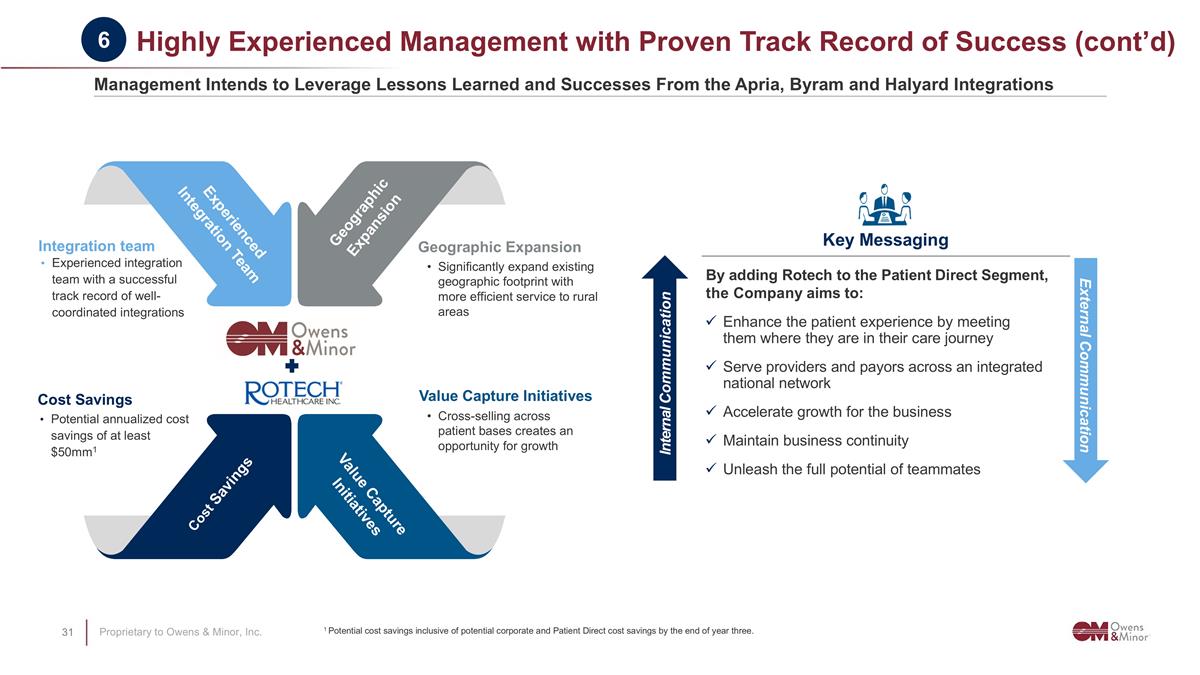
Highly Experienced Management with Proven Track Record of Success (cont’d) Integration team Experienced integration team with a successful track record of well-coordinated integrations Value Capture Initiatives Experienced Integration Team Geographic Expansion Cost Savings Value Capture Initiatives Cost Savings Potential annualized cost savings of at least $50mm1 Geographic Expansion Significantly expand existing geographic footprint with more efficient service to rural areas Cross-selling across patient bases creates an opportunity for growth Management Intends to Leverage Lessons Learned and Successes From the Apria, Byram and Halyard Integrations Key Messaging By adding Rotech to the Patient Direct Segment, the Company aims to: Enhance the patient experience by meeting them where they are in their care journey Serve providers and payors across an integrated national network Accelerate growth for the business Maintain business continuity Unleash the full potential of teammates External Communication Internal Communication 1 Potential cost savings inclusive of potential corporate and Patient Direct cost savings by the end of year three. 6 Proprietary to Owens & Minor, Inc.
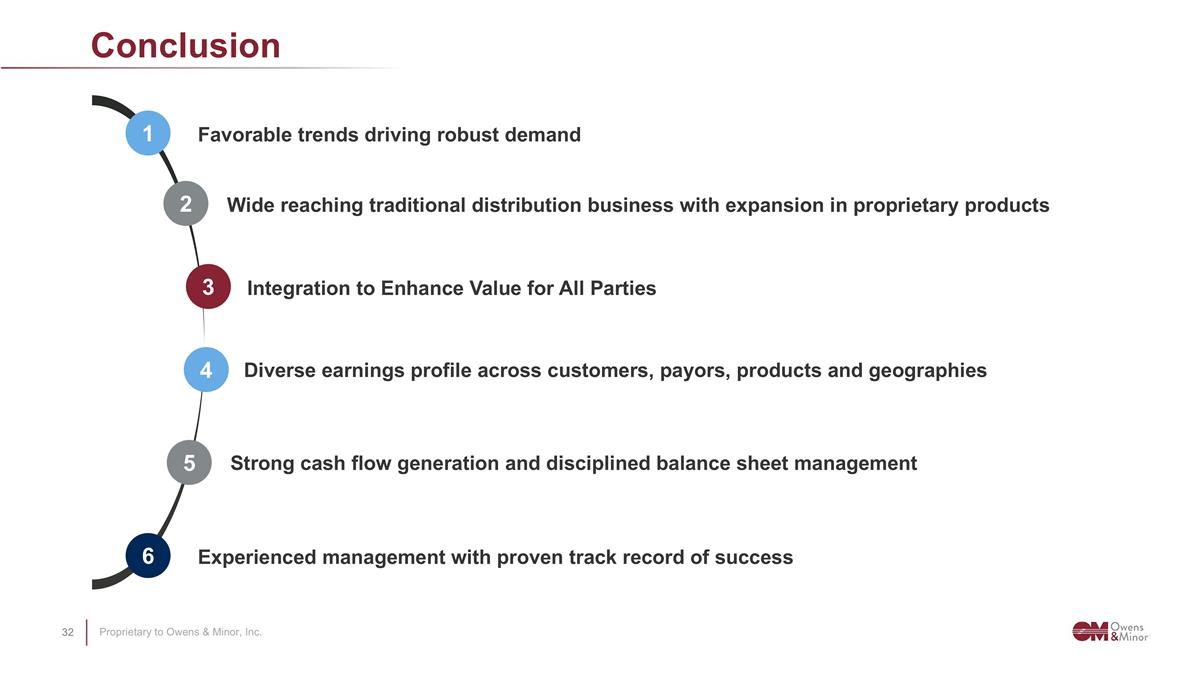
Conclusion 1 Favorable trends driving robust demand 5 Strong cash flow generation and disciplined balance sheet management 4 Diverse earnings profile across customers, payors, products and geographies 2 Wide reaching traditional distribution business with expansion in proprietary products 6 Experienced management with proven track record of success Integration to Enhance Value for All Parties 3 Proprietary to Owens & Minor, Inc.
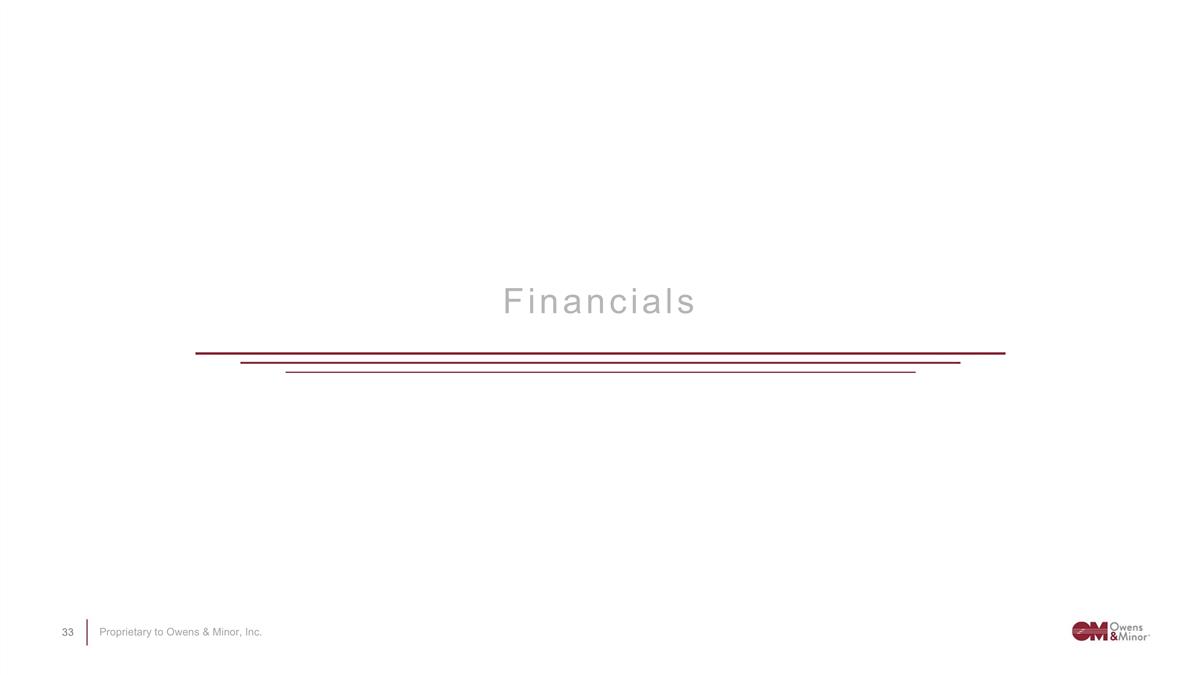
Financials Proprietary to Owens & Minor, Inc.
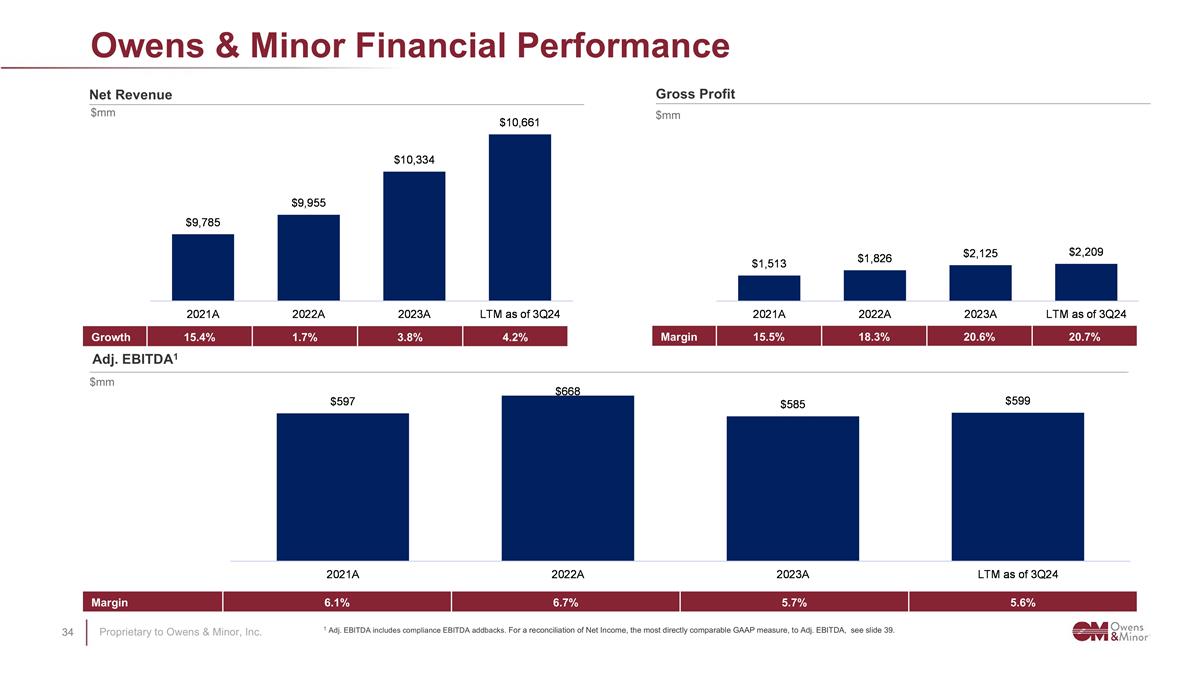
Owens & Minor Financial Performance Net Revenue Gross Profit Adj. EBITDA1 $mm $mm $mm Margin 15.5% 18.3% 20.6% 20.7% Margin 6.1% 6.7% 5.7% 5.6% Growth 15.4% 1.7% 3.8% 4.2% 1 Adj. EBITDA includes compliance EBITDA addbacks. For a reconciliation of Net Income, the most directly comparable GAAP measure, to Adj. EBITDA, see slide 39. Proprietary to Owens & Minor, Inc.
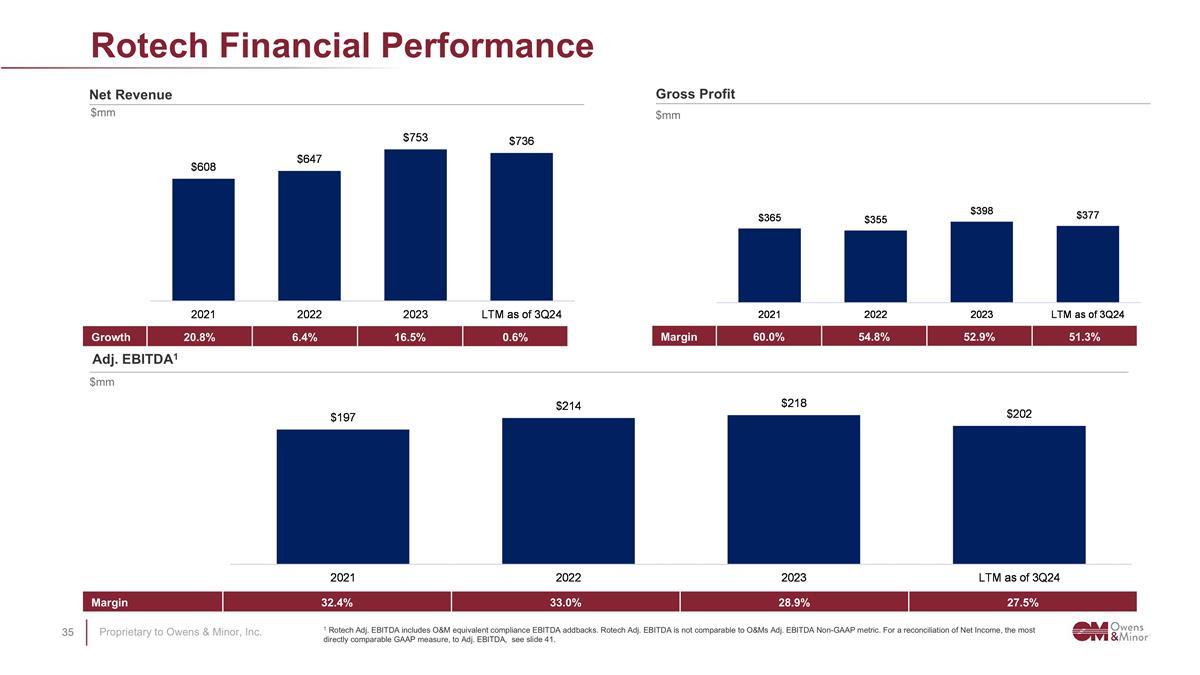
Rotech Financial Performance Net Revenue Gross Profit Adj. EBITDA1 $mm $mm $mm Margin 60.0% 54.8% 52.9% 51.3% Margin 32.4% 33.0% 28.9% 27.5% Growth 20.8% 6.4% 16.5% 0.6% 1 Rotech Adj. EBITDA includes O&M equivalent compliance EBITDA addbacks. Rotech Adj. EBITDA is not comparable to O&Ms Adj. EBITDA Non-GAAP metric. For a reconciliation of Net Income, the most directly comparable GAAP measure, to Adj. EBITDA, see slide 41. Proprietary to Owens & Minor, Inc.
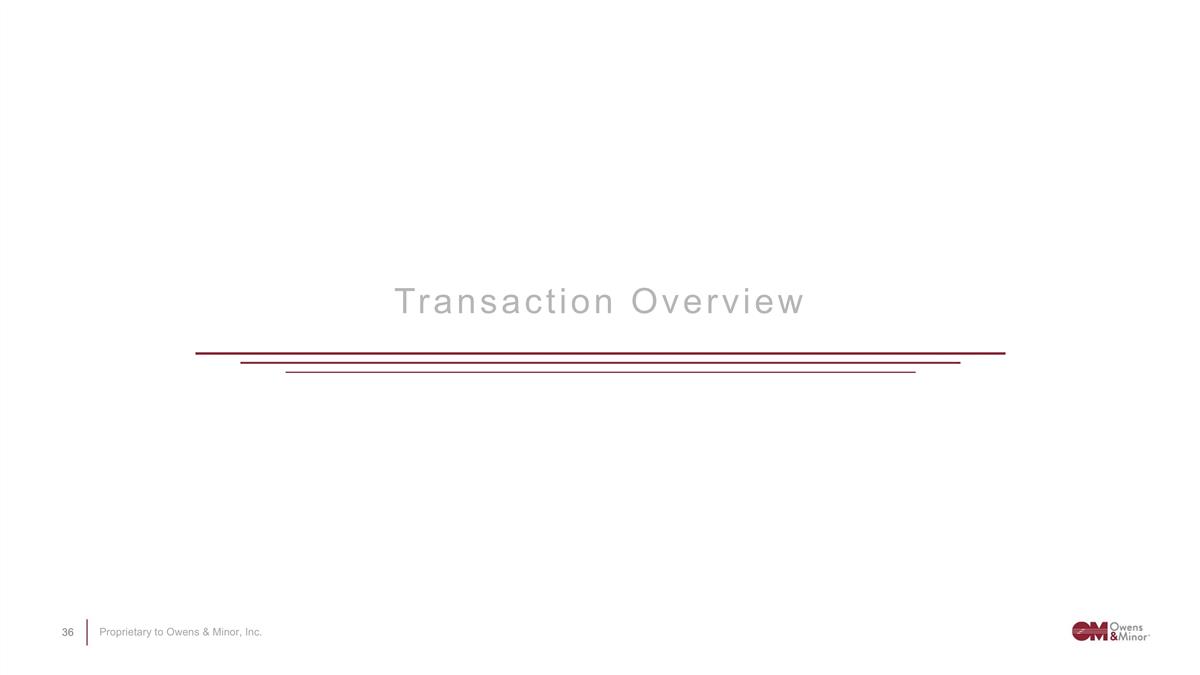
Transaction Overview Proprietary to Owens & Minor, Inc.
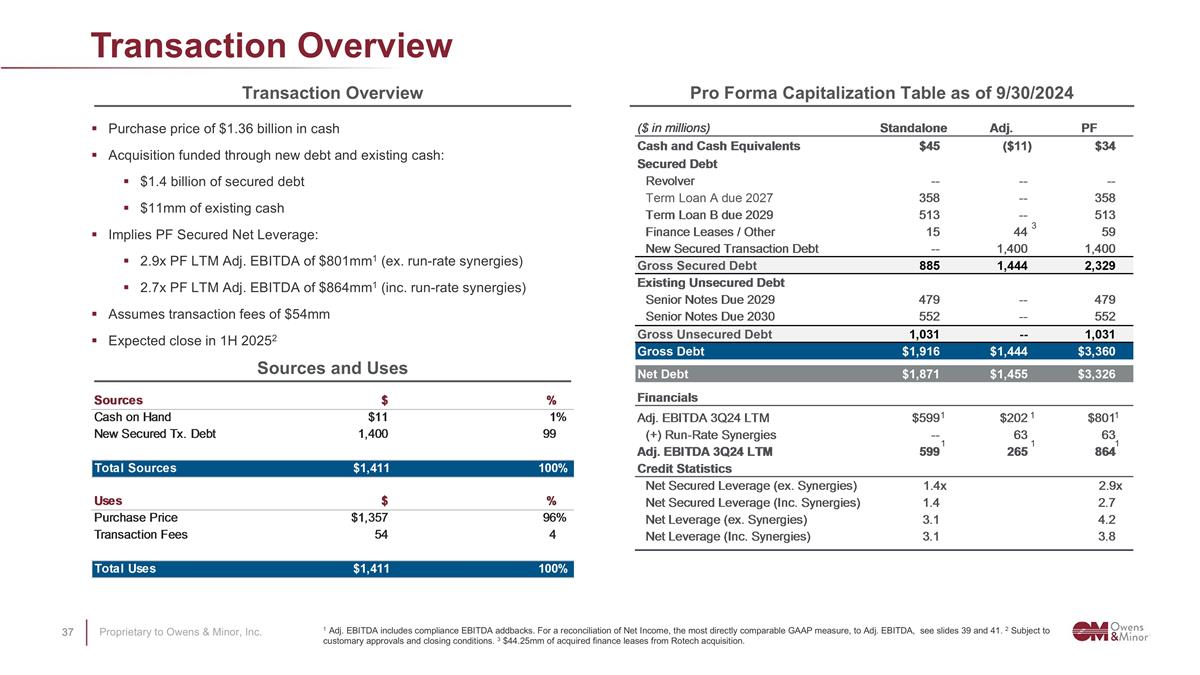
Transaction Overview Transaction Overview Sources and Uses Pro Forma Capitalization Table as of 9/30/2024 Purchase price of $1.36 billion in cash Acquisition funded through new debt and existing cash: $1.4 billion of secured debt $11mm of existing cash Implies PF Secured Net Leverage: 2.9x PF LTM Adj. EBITDA of $801mm1 (ex. run-rate synergies) 2.7x PF LTM Adj. EBITDA of $864mm1 (inc. run-rate synergies) Assumes transaction fees of $54mm Expected close in 1H 20252 1 Adj. EBITDA includes compliance EBITDA addbacks. For a reconciliation of Net Income, the most directly comparable GAAP measure, to Adj. EBITDA, see slides 39 and 41. 2 Subject to customary approvals and closing conditions. 3 $44.25mm of acquired finance leases from Rotech acquisition. 3 Proprietary to Owens & Minor, Inc. 1 1 1 1 1 1
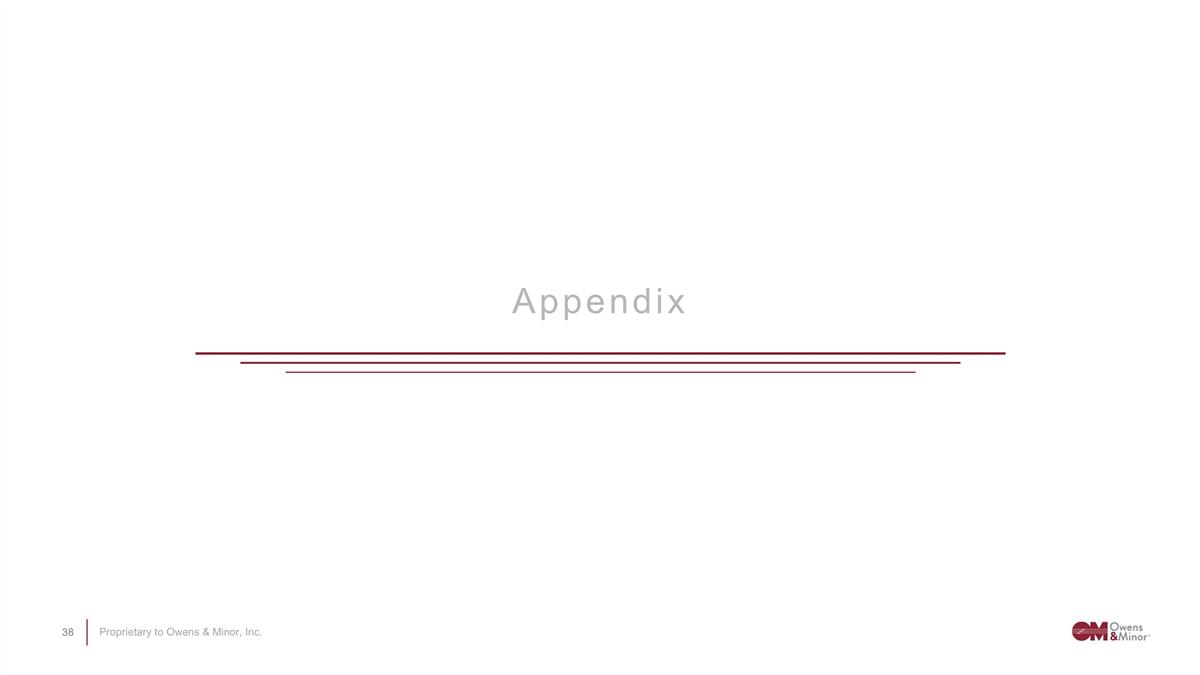
Appendix Proprietary to Owens & Minor, Inc.
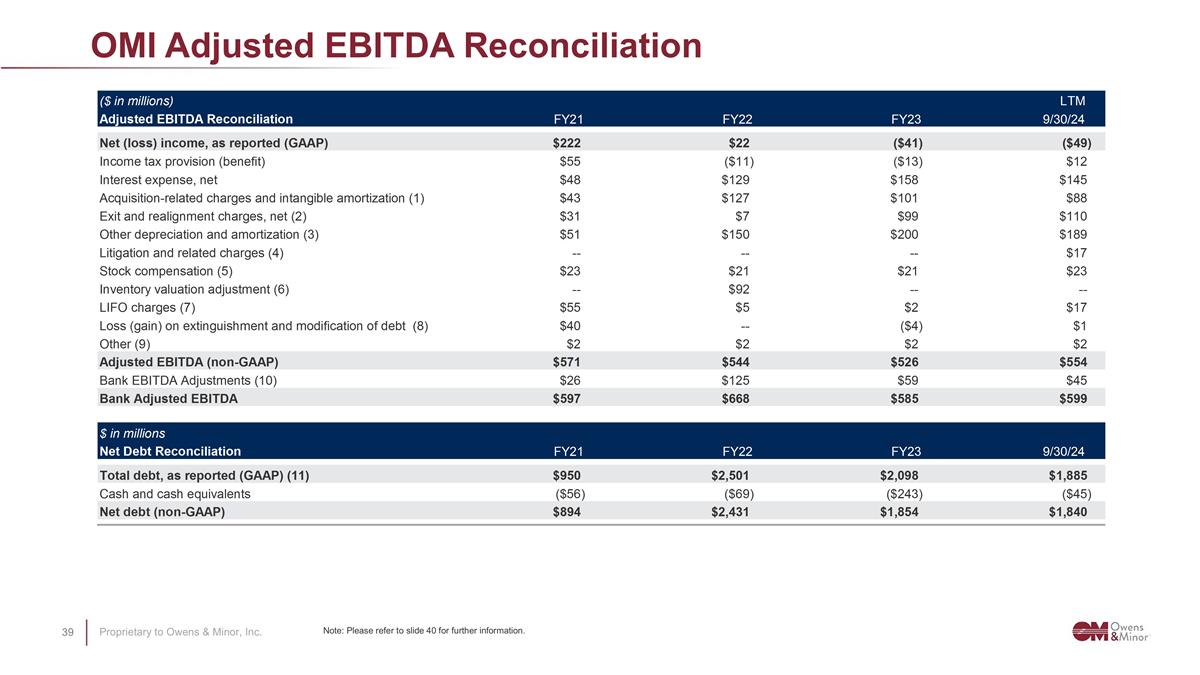
OMI Adjusted EBITDA Reconciliation Note: Please refer to slide 40 for further information. Proprietary to Owens & Minor, Inc.
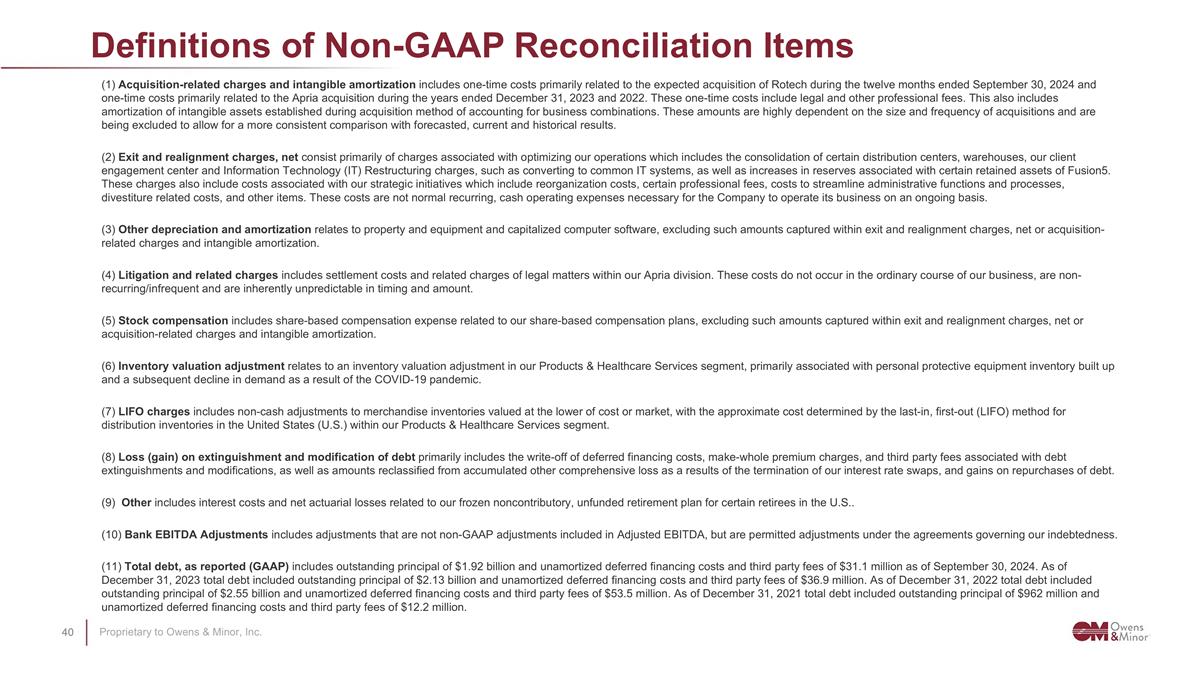
Definitions of Non-GAAP Reconciliation Items (1) Acquisition-related charges and intangible amortization includes one-time costs primarily related to the expected acquisition of Rotech during the twelve months ended September 30, 2024 and one-time costs primarily related to the Apria acquisition during the years ended December 31, 2023 and 2022. These one-time costs include legal and other professional fees. This also includes amortization of intangible assets established during acquisition method of accounting for business combinations. These amounts are highly dependent on the size and frequency of acquisitions and are being excluded to allow for a more consistent comparison with forecasted, current and historical results. (2) Exit and realignment charges, net consist primarily of charges associated with optimizing our operations which includes the consolidation of certain distribution centers, warehouses, our client engagement center and Information Technology (IT) Restructuring charges, such as converting to common IT systems, as well as increases in reserves associated with certain retained assets of Fusion5. These charges also include costs associated with our strategic initiatives which include reorganization costs, certain professional fees, costs to streamline administrative functions and processes, divestiture related costs, and other items. These costs are not normal recurring, cash operating expenses necessary for the Company to operate its business on an ongoing basis. (3) Other depreciation and amortization relates to property and equipment and capitalized computer software, excluding such amounts captured within exit and realignment charges, net or acquisition-related charges and intangible amortization. (4) Litigation and related charges includes settlement costs and related charges of legal matters within our Apria division. These costs do not occur in the ordinary course of our business, are non-recurring/infrequent and are inherently unpredictable in timing and amount. (5) Stock compensation includes share-based compensation expense related to our share-based compensation plans, excluding such amounts captured within exit and realignment charges, net or acquisition-related charges and intangible amortization. (6) Inventory valuation adjustment relates to an inventory valuation adjustment in our Products & Healthcare Services segment, primarily associated with personal protective equipment inventory built up and a subsequent decline in demand as a result of the COVID-19 pandemic. (7) LIFO charges includes non-cash adjustments to merchandise inventories valued at the lower of cost or market, with the approximate cost determined by the last-in, first-out (LIFO) method for distribution inventories in the United States (U.S.) within our Products & Healthcare Services segment. (8) Loss (gain) on extinguishment and modification of debt primarily includes the write-off of deferred financing costs, make-whole premium charges, and third party fees associated with debt extinguishments and modifications, as well as amounts reclassified from accumulated other comprehensive loss as a results of the termination of our interest rate swaps, and gains on repurchases of debt. (9) Other includes interest costs and net actuarial losses related to our frozen noncontributory, unfunded retirement plan for certain retirees in the U.S.. (10) Bank EBITDA Adjustments includes adjustments that are not non-GAAP adjustments included in Adjusted EBITDA, but are permitted adjustments under the agreements governing our indebtedness. (11) Total debt, as reported (GAAP) includes outstanding principal of $1.92 billion and unamortized deferred financing costs and third party fees of $31.1 million as of September 30, 2024. As of December 31, 2023 total debt included outstanding principal of $2.13 billion and unamortized deferred financing costs and third party fees of $36.9 million. As of December 31, 2022 total debt included outstanding principal of $2.55 billion and unamortized deferred financing costs and third party fees of $53.5 million. As of December 31, 2021 total debt included outstanding principal of $962 million and unamortized deferred financing costs and third party fees of $12.2 million. Proprietary to Owens & Minor, Inc.
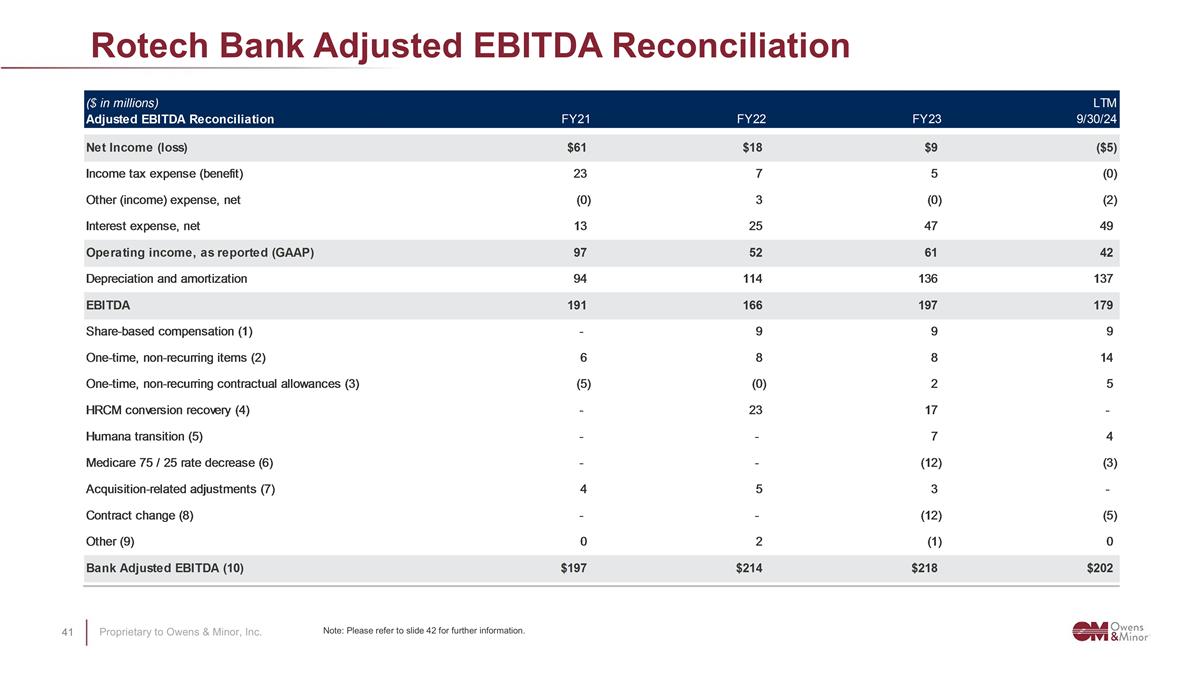
Rotech Bank Adjusted EBITDA Reconciliation Proprietary to Owens & Minor, Inc. Note: Please refer to slide 42 for further information.
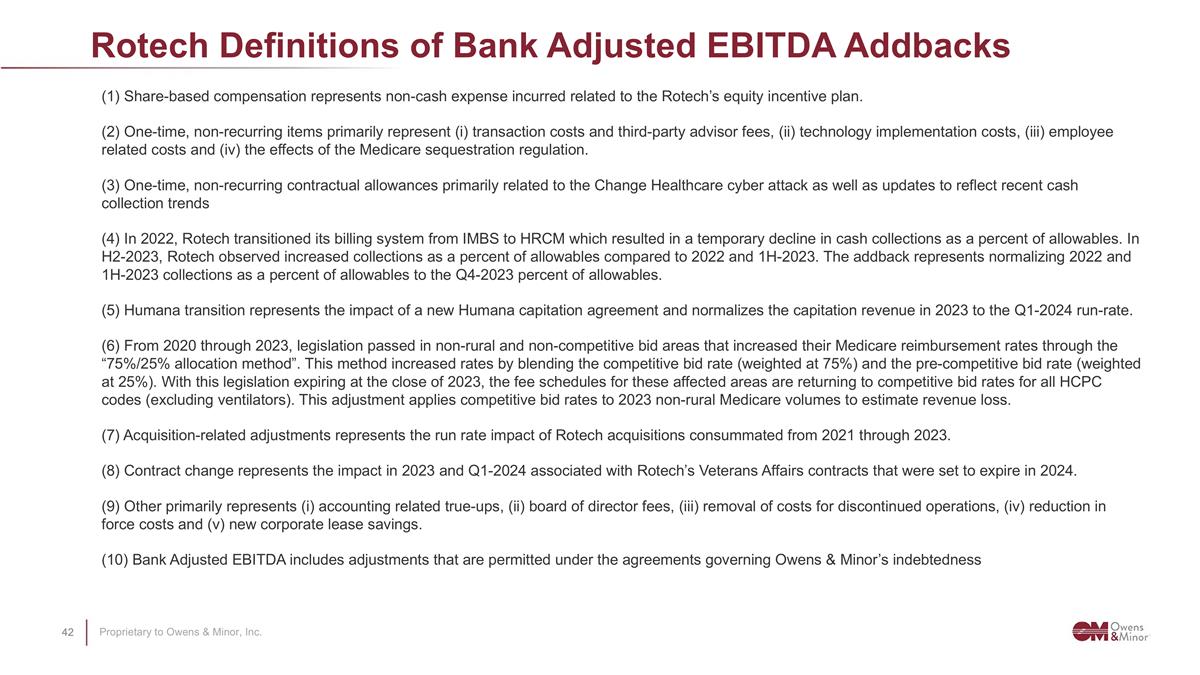
Rotech Definitions of Bank Adjusted EBITDA Addbacks Proprietary to Owens & Minor, Inc. (1) Share-based compensation represents non-cash expense incurred related to the Rotech’s equity incentive plan. (2) One-time, non-recurring items primarily represent (i) transaction costs and third-party advisor fees, (ii) technology implementation costs, (iii) employee related costs and (iv) the effects of the Medicare sequestration regulation. (3) One-time, non-recurring contractual allowances primarily related to the Change Healthcare cyber attack as well as updates to reflect recent cash collection trends (4) In 2022, Rotech transitioned its billing system from IMBS to HRCM which resulted in a temporary decline in cash collections as a percent of allowables. In H2-2023, Rotech observed increased collections as a percent of allowables compared to 2022 and 1H-2023. The addback represents normalizing 2022 and 1H-2023 collections as a percent of allowables to the Q4-2023 percent of allowables. (5) Humana transition represents the impact of a new Humana capitation agreement and normalizes the capitation revenue in 2023 to the Q1-2024 run-rate. (6) From 2020 through 2023, legislation passed in non-rural and non-competitive bid areas that increased their Medicare reimbursement rates through the “75%/25% allocation method”. This method increased rates by blending the competitive bid rate (weighted at 75%) and the pre-competitive bid rate (weighted at 25%). With this legislation expiring at the close of 2023, the fee schedules for these affected areas are returning to competitive bid rates for all HCPC codes (excluding ventilators). This adjustment applies competitive bid rates to 2023 non-rural Medicare volumes to estimate revenue loss. (7) Acquisition-related adjustments represents the run rate impact of Rotech acquisitions consummated from 2021 through 2023. (8) Contract change represents the impact in 2023 and Q1-2024 associated with Rotech’s Veterans Affairs contracts that were set to expire in 2024. (9) Other primarily represents (i) accounting related true-ups, (ii) board of director fees, (iii) removal of costs for discontinued operations, (iv) reduction in force costs and (v) new corporate lease savings. (10) Bank Adjusted EBITDA includes adjustments that are permitted under the agreements governing Owens & Minor’s indebtedness